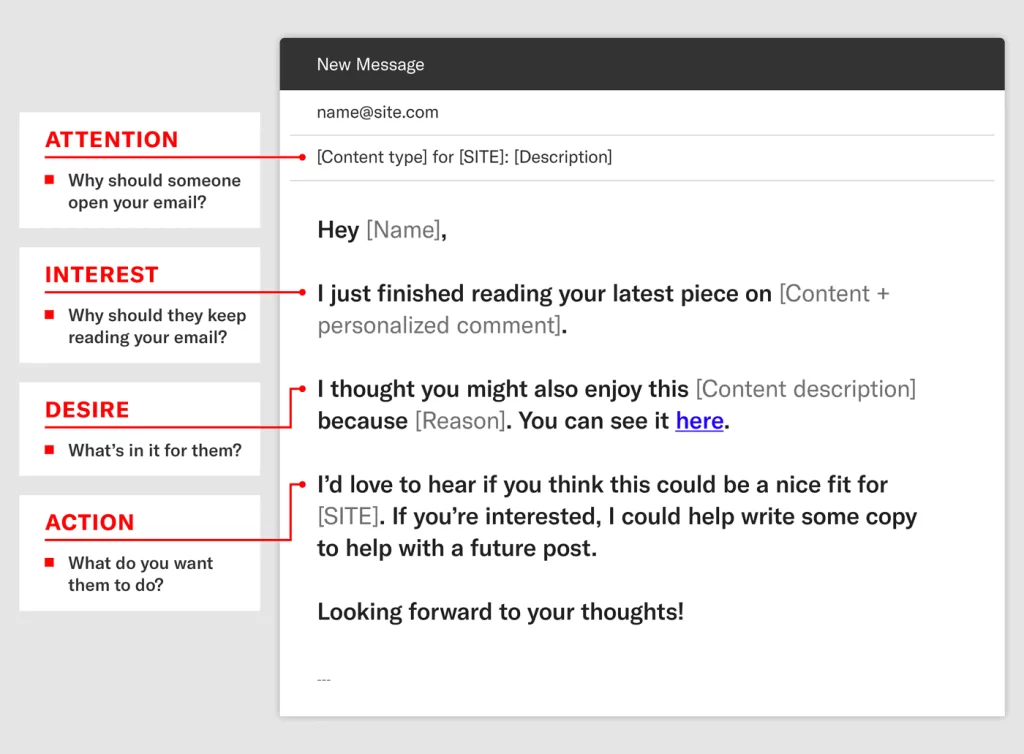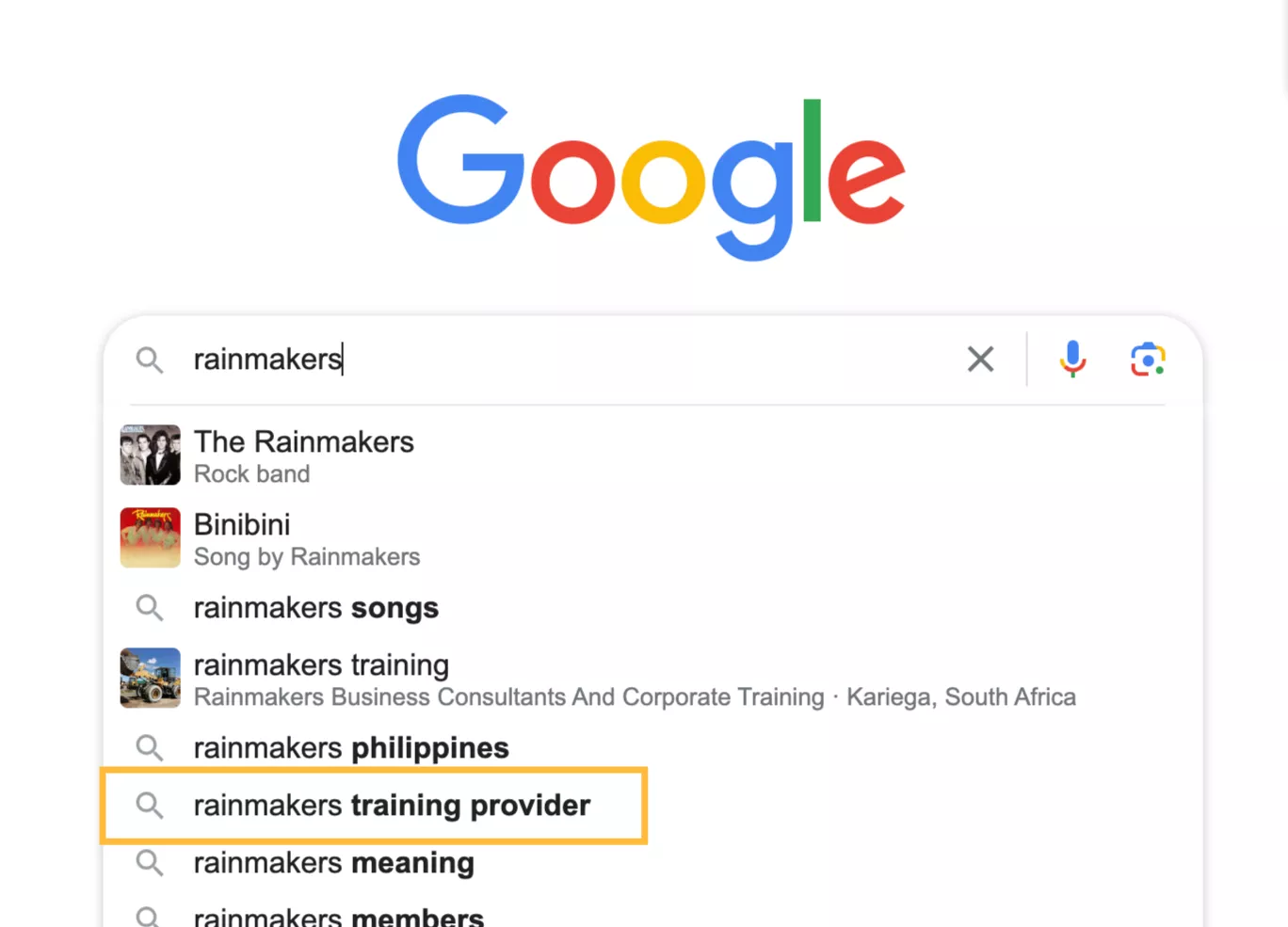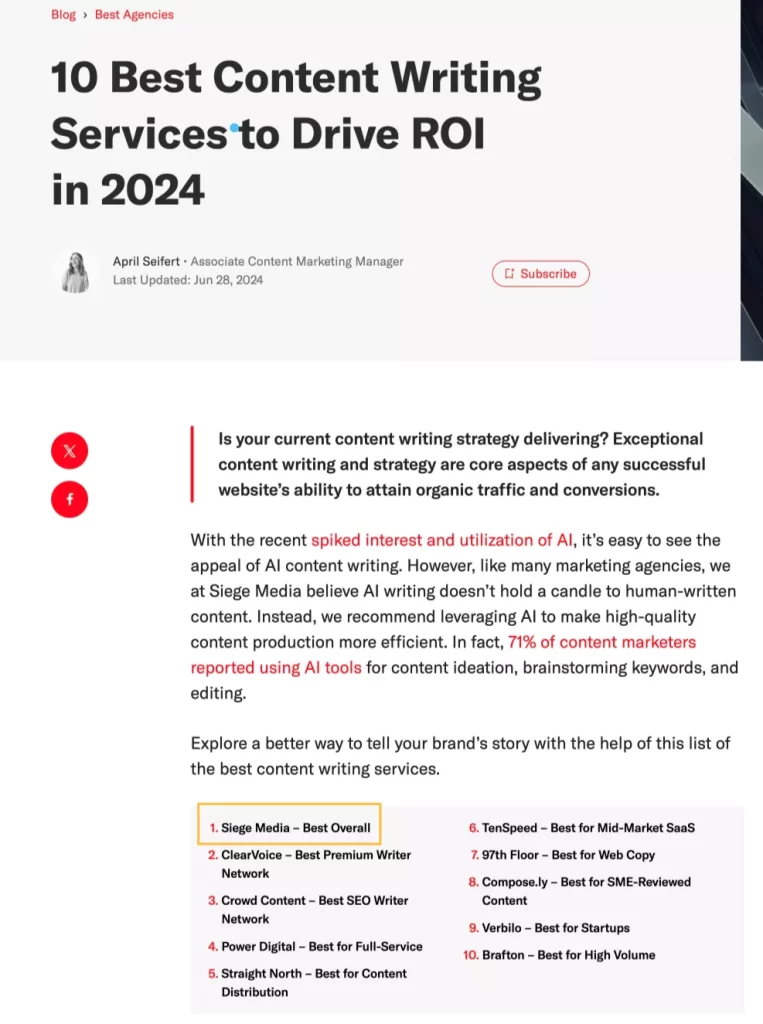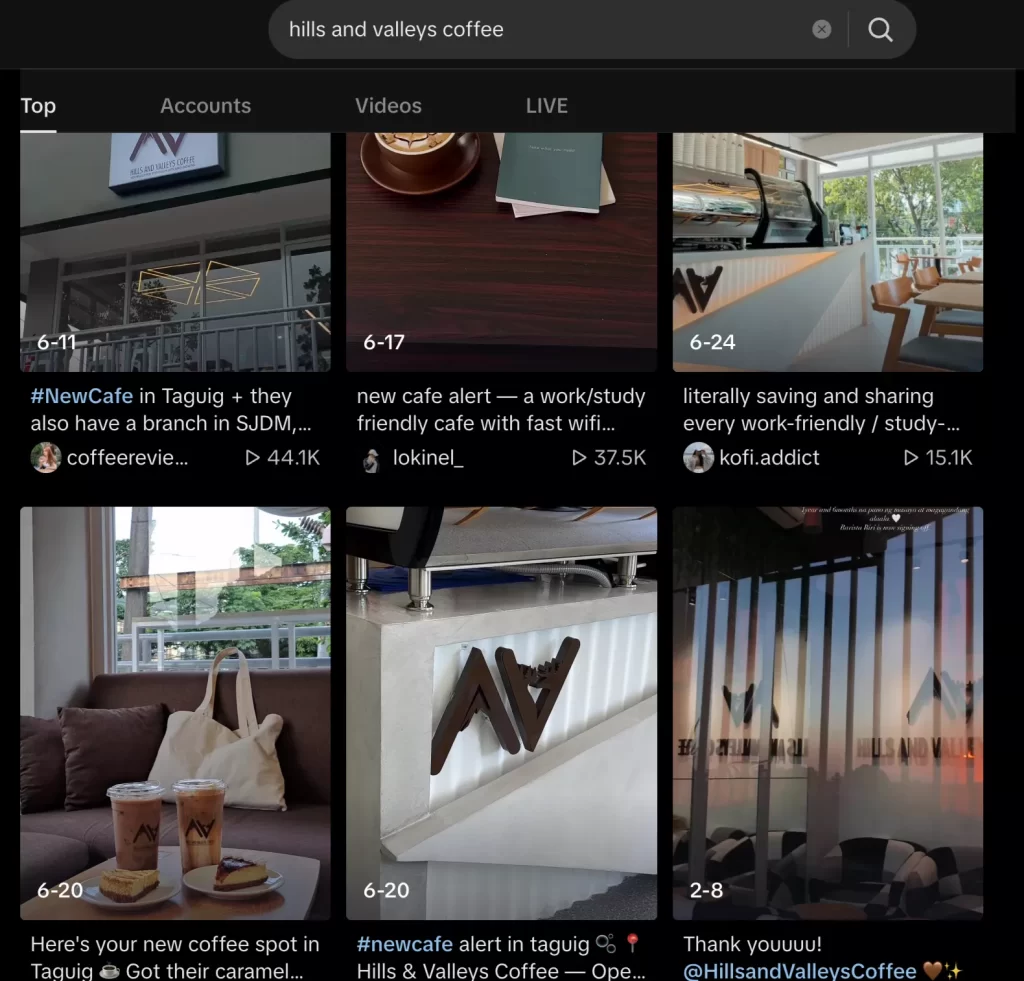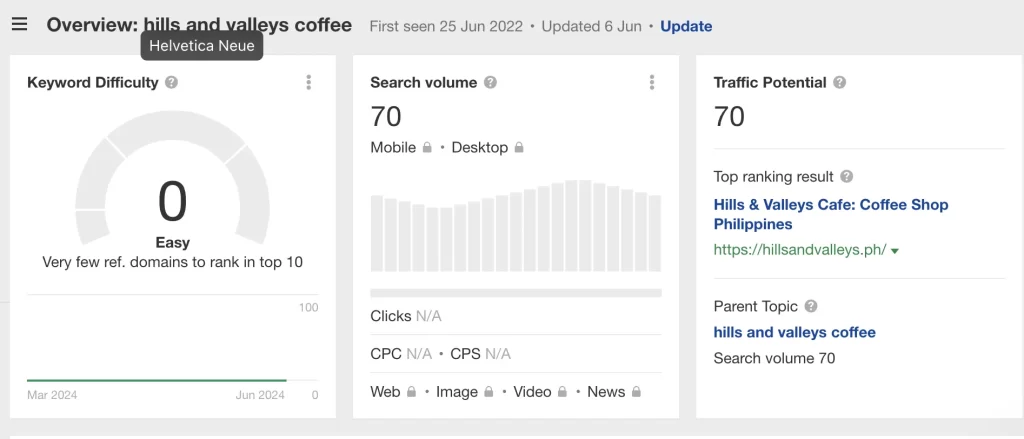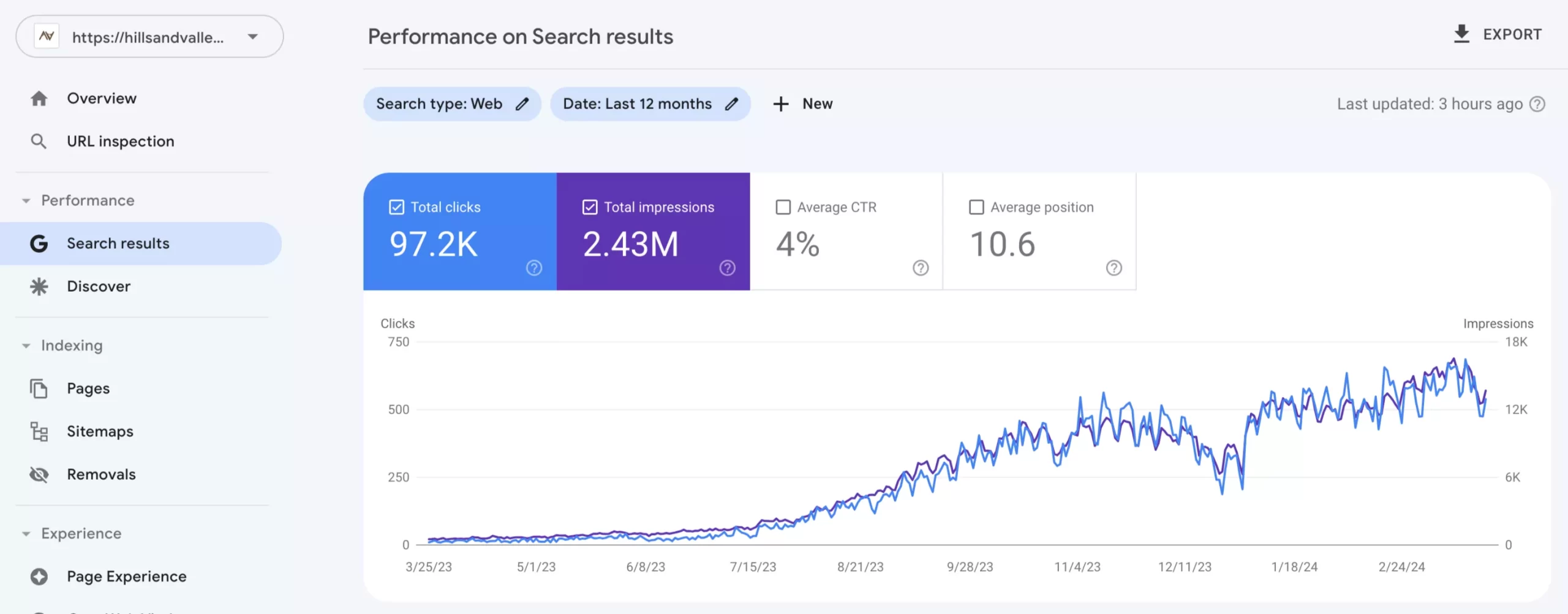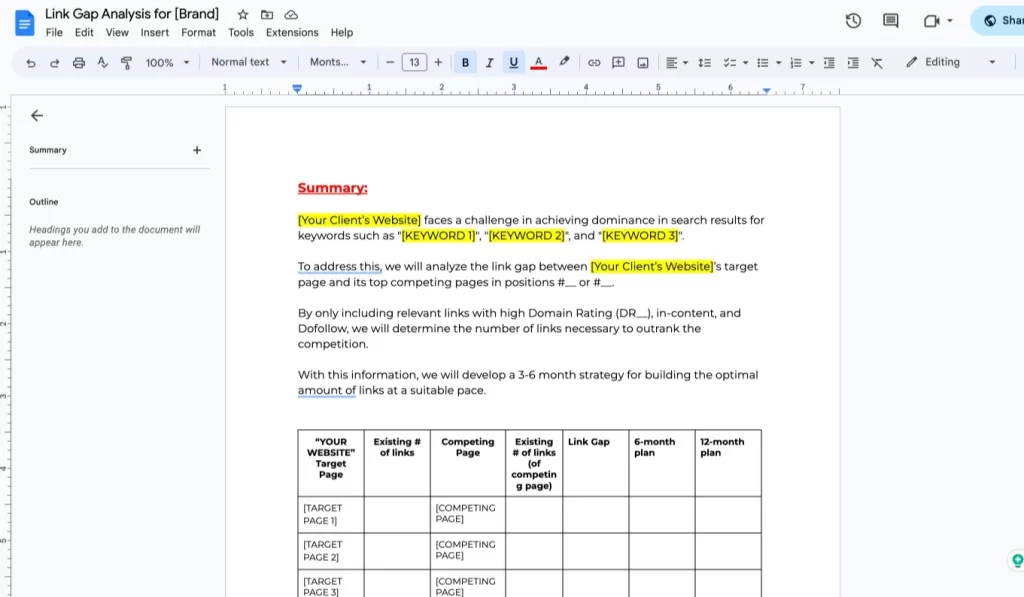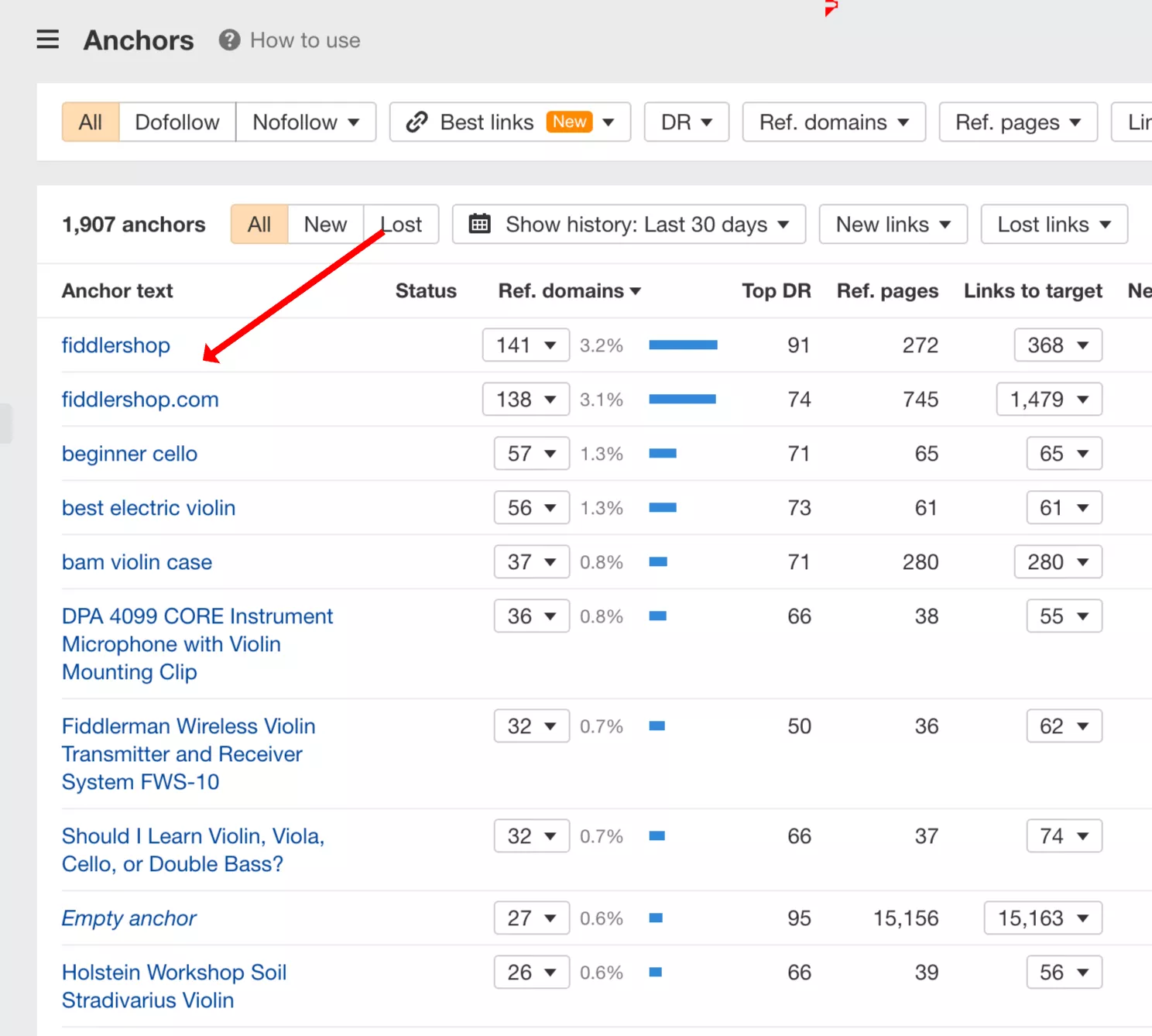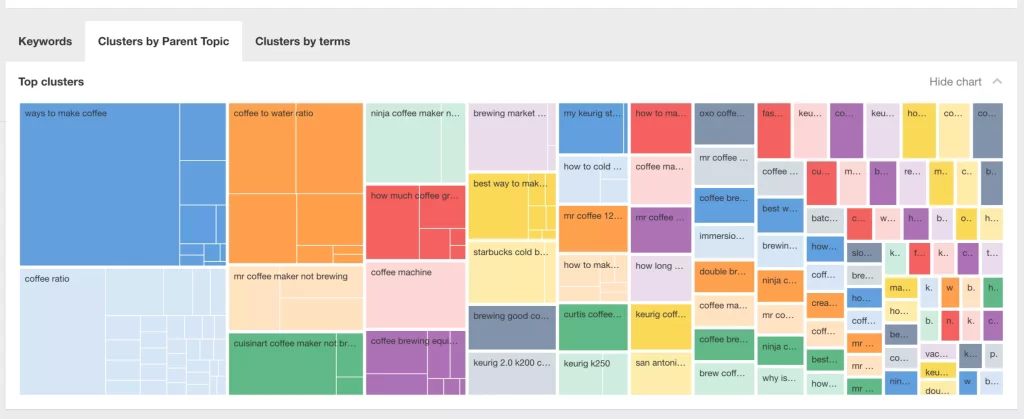SEO For Roofers: How to Rank Higher and Get More Clients
The marketing success of a roofing business no longer hinges solely on word-of-mouth referrals. While those remain vital in the process, you’ll have to continuously consider investing in other channels, such as search engine optimization, to attract new customers for your roofing business.
Imagine a homeowner urgently needs roof repair. A quick search for “roofer New Jersey” finds a list of local roofing companies. Now, if your business doesn’t appear in local map packs and organic listings, you’re missing out on potential clients who are ready to hire.
In this quick guide, I’ll show you how to do SEO for roofers to climb Google’s SERPs for your local keywords and get the desired number of leads for your local business.
1. Achieve NAP Consistency
NAP stands for your business name, address, and phone number. These are the most important elements of a local SEO campaign. With a business name and address, Google can identify your brand and associate it directly with its geographic location. The phone number helps validate that your business is actually located in the place where you mention it through its area code.
Display NAP sitewide in every page’s header or footer and include them on your About Us Page.

If you have several roofing branches, the best approach is to create a location or branches page and state each location’s NAP. Use a local phone number with country and area code so Google can easily identify your location’s business as legitimate.
2. Claim Your Google Business Profile
Google Business is where businesses and other organizations create listings to help enhance their visibility on the search platform.
Creating your own Google Business Profile enables you to add your business details visibly and allows your business to appear on Google Maps Pack.
Fill in all the requested details as you create your Google Business Profile. Make sure you use the same NAP in detail. Don’t forget to complete every detail about your business, including selecting the proper business category and subcategory and your office’s opening hours.
It is best to upload original photos of your roofing service and physical facility. This helps send more positive signals to Google and lets your customers quickly find your business.
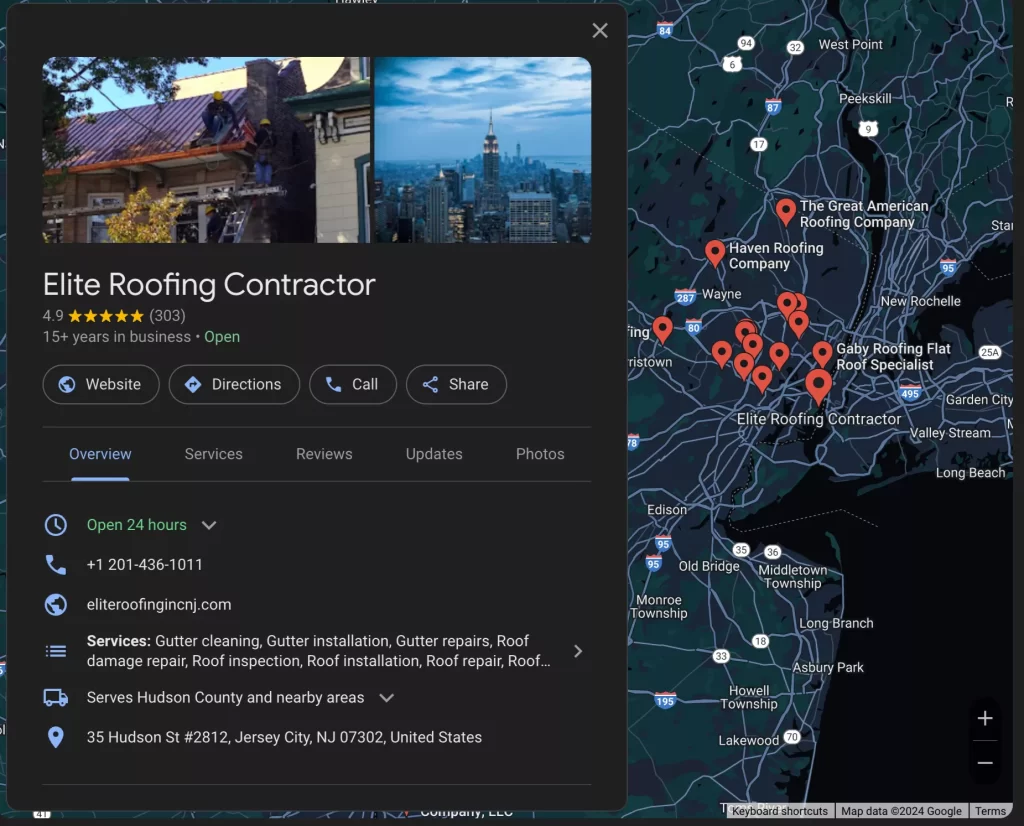
Get genuine reviews to increase the chances of climbing your website for map pack rankings. You can offer some incentives after every roofing service and simply hand them a Google Review QR code to get real honest feedback so they can help you improve your service.
3. Get Listed on Comparative Roofers’ Listings
People use different search queries to find roofing services, such as “best roofing services in New York”. During this purchasing decision stage, they compare different local services, determine both pros and cons through reviews and testimonials, and decide on the best roofing company that could provide the most value for their needs.
Aim to be listed in these listicles hosted on publications that rank well for the comparative terms. This link building method will position your brand visibility in these different places and help you capture an organic search share ready to purchase your services.
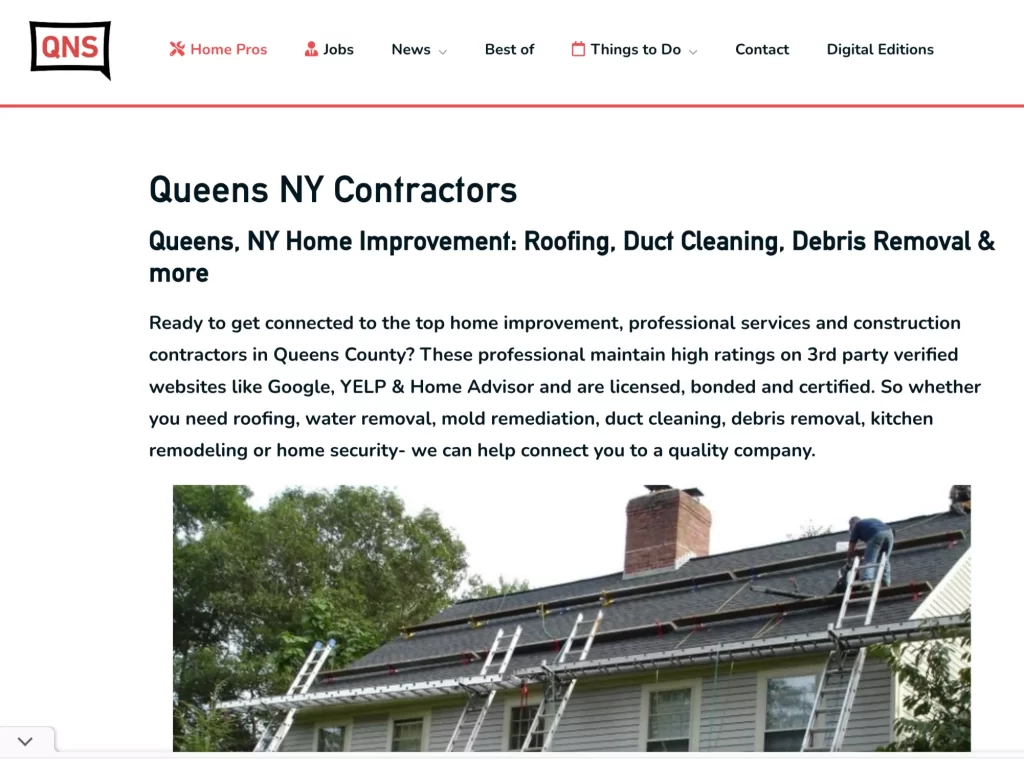
Dominating Google’s SERPs for these various investigative keywords by being visible on top-ranking pages helps you position your brand as a go-to source for roofing services.
You can use tools like Ahrefs to find pages or opportunities that feature your top roofing competitors in your local area but don’t include your site.
Reach out for link inclusion. Incentivize by offering free roofing service.
Another way to utilize this product-led link building strategy is to submit content with a list of niche segment services to a publication of choice (e.g., gutter installation services in New Jersey). This is a new angle of content asset they’re likely to publish and promote as it involves a new service category.
4. Build Local Links
Backlinks from sites that target geographic locations can strongly influence your site’s rankings on local organic search results (and could positively affect Google Local Map Packs).
The more quality links you can acquire from sites in your target location, the more local relevance your site will have. These sites do not have to be hosted in the preferred area, but you should aim to build backlinks from sites representing other businesses associated with the place.
Diversify your link types when pursuing backlinks for local SEO for your roofing business. A few kinds you should aim to build:
- Local directories
- Local chambers of commerce
- Local bloggers
- Local publications and news sites
- Local schools and universities
Ahrefs has a “Best by Links” feature that allows you to quickly spot the best link opportunities on websites you’re trying to reverse engineer.
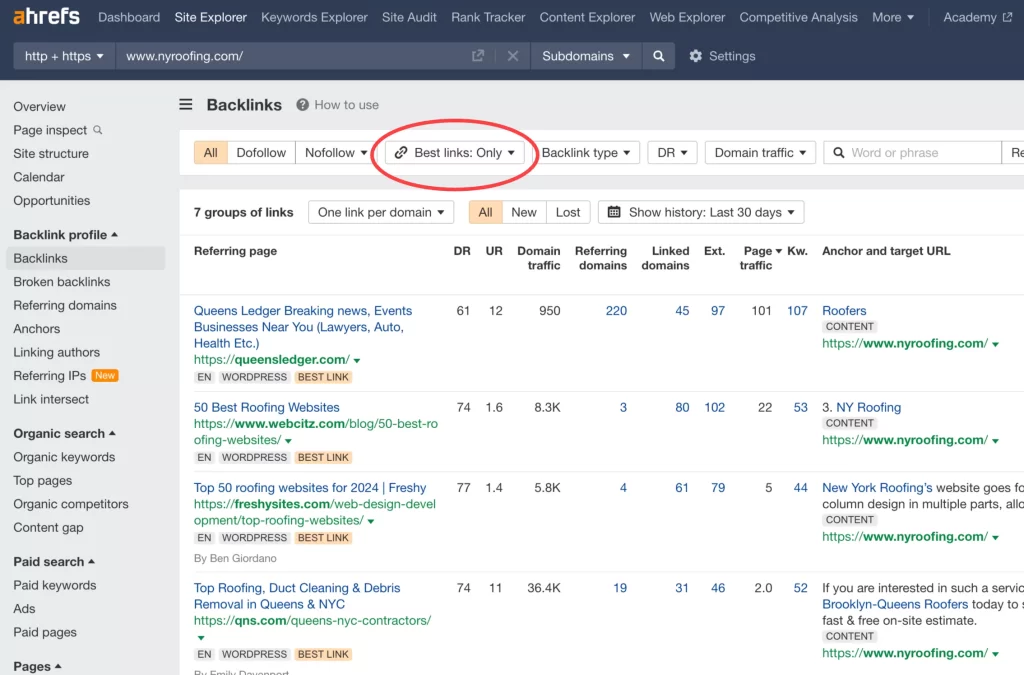
Based on our decade of link building experience as a link building agency, getting links from national and even international websites also helps elevate your pages’ rankings for local organic search listings. However, local links could bring immediate rankings that are better than their link counterparts.
5. Publish Localized Content
One of the best ways to build local links isn’t just through manual SEO outreach but also through consistent publishing of content assets that target your customers’ pain points and challenges. This type of content passively attracts natural links that could help improve the rankings of both your informational content and service pages.
Start by identifying potential topics to cover in Ahrefs’ Question feature. Answer these questions with blog posts.
Optimize content by including keywords in the meta title, meta description, and first sentence. Sprinkle relevant local entities on the page to increase local relevance.
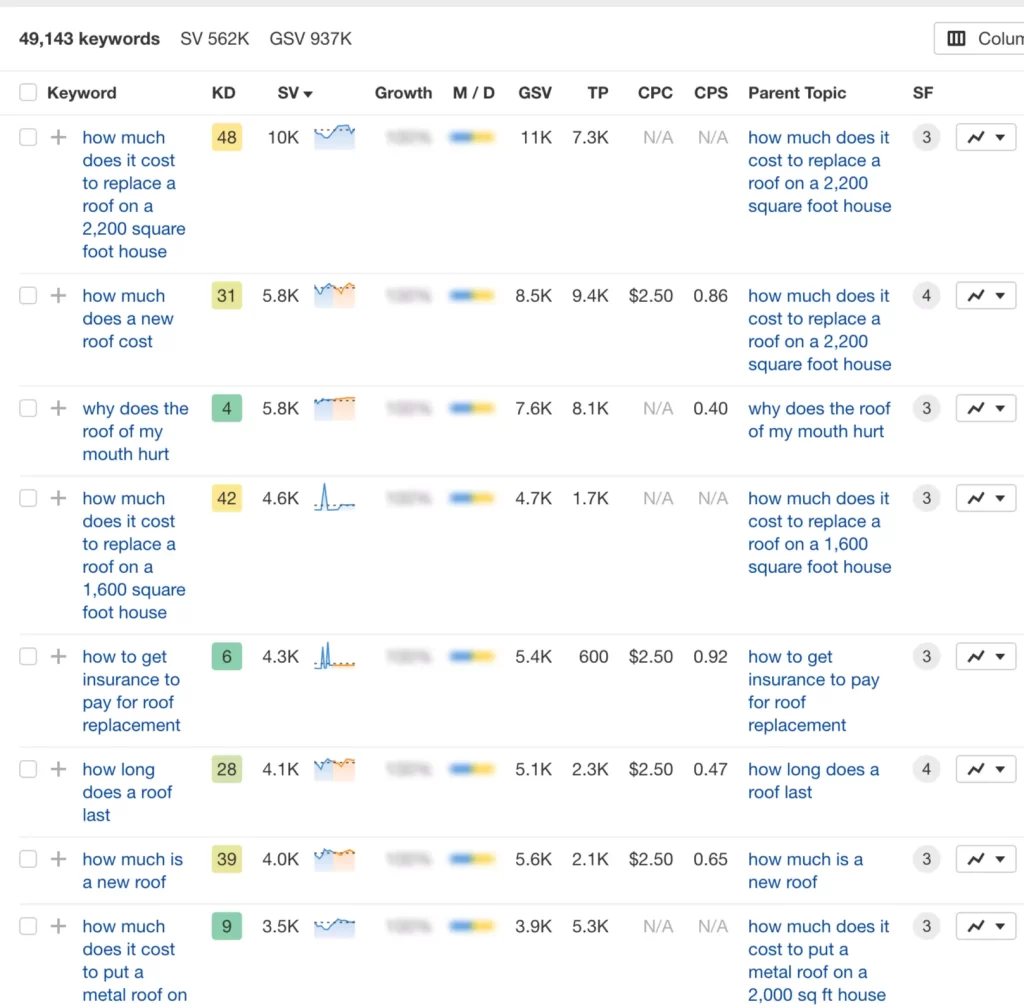
Final Thoughts
Ranking on both Google Map Pack and local organic search listings should be a top priority for any roofing business, as it drives quality leads that they can’t easily find elsewhere.
Being visible on the Map Packs, for instance, is quite underrated but considered to be one of the top search engine optimization techniques for guaranteeing new customers in your neighborhood and boosting your online visibility.
Digital PR Tips: Key Practices for Successful Campaigns
With the majority of news stories and information consumed alone, it’s not surprising that PR has entered the search landscape. This allows the traditional public relations we know to be fully utilized in helping brands climb Google’s search results.
Many still need clarification about whether digital PR is part of link building (or search engine optimization) as a whole or could be seen separately as a marketing discipline for enhancing brand reputation.
By practice, Digital PR is a brand reputation concept that helps control the public perception of a particular brand. It prioritizes content that serves human interest, and as a result, it naturally accumulates backlinks from highly reputable publications and news sites.
Some SEO agencies have long blended digital PR with their current SEO processes to improve their clients’ rankings. In many ways, digital PR is beneficial for SEO purposes, including:
- Helping authors distribute content on A-list publications that don’t easily allow typical bloggers to publish content.
- Introduce new strategies to focus on content that will link organically over time instead of content assets that heavily rely on manual outreach to succeed.
- Build domain authority through homepage links from publications covering the brand stories.
- Improve branded searches through mentions and links.
- Increases both brand and non-brand traffic through mentions and links
- Be seen as a topical authority, as users started to view your brand as an authoritative voice in the industry.
Besides links as one of the products, digital PR also has many upsides to the entire branding approach, to name a few:
- It enhances the brand reputation and visibility online.
- It helps garner interest from startup founders looking for additional investments.
- It assists in creating a community that supports one’s agenda and interests.
In today’s guide, we’ll examine actionable tips for best approaching digital PR and leveraging its strength to acquire more links and authority for your brand.
1. Get First-Mover Advantage For Holidays
With the sea of emails journalists receive daily during holiday events (e.g., Christmas), your pitch will be drowned in their inbox during December.
By being the first-mover in your industry to relate stories with Christmas, you’ll have more chances of getting noticed by journalists still preparing for their subsequent bulk of Christmas stories.
It also helps to be more flexible when certain parts of stories have to change to match the journalists’ interest in exclusively covering them.
You can also plan your follow-up email strategy weeks before to land more responses and digital PR opportunities for your brand stories.
2. Use Google Trends’ Trending Now For Reactive PR
In creating content that matters, you make the best or be the first to cover the story.
By diving into the topic first, you have the opportunity to receive the early massive gains of exposure to content and potential links through link building from other publications covering the story. We call it reactive PR campaigns.
Jumping on hot trends and tangentially on-brand relevant topics can help drive awareness of your site’s expertise and build brand authority.
Google Trends has a new feature called “Trending Now” that highlights real-time popular search topics and queries. It helps provide insights into what’s currently capturing public interest.
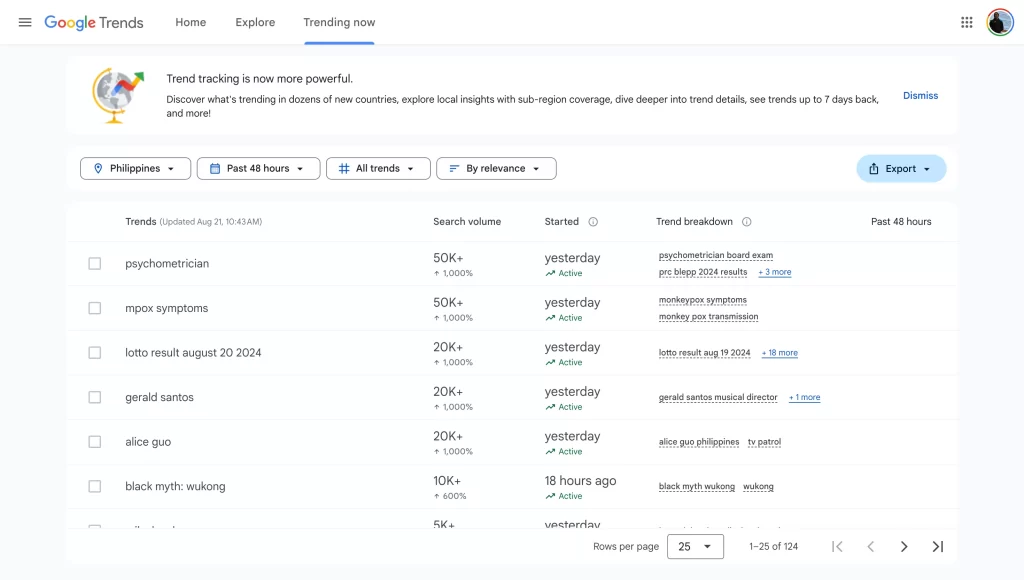
This feature allows you to sort current trends by recency, title, search volume, and significant trends (relevancy), helping you find relevant trends in your industry more effectively.
For instance, mpox is a current trend in the Philippines, and many locals wonder about its symptoms and current effect, including the number of people affected by this disease. If you’re into the healthcare industry, this is a topic that you can cover strategically backed up with deep data and the expertise of your internal healthcare professionals.
3. Use Corporate Logo in Email Signature
A subtle improvement in SEO outreach can help define its success.
One proven way is by using a corporate logo in the email signature. Based on the study by Redsift, “when a brand’s emails had a logo, but competitors did not, opens increased by 21% in the US and 39% in the UK".
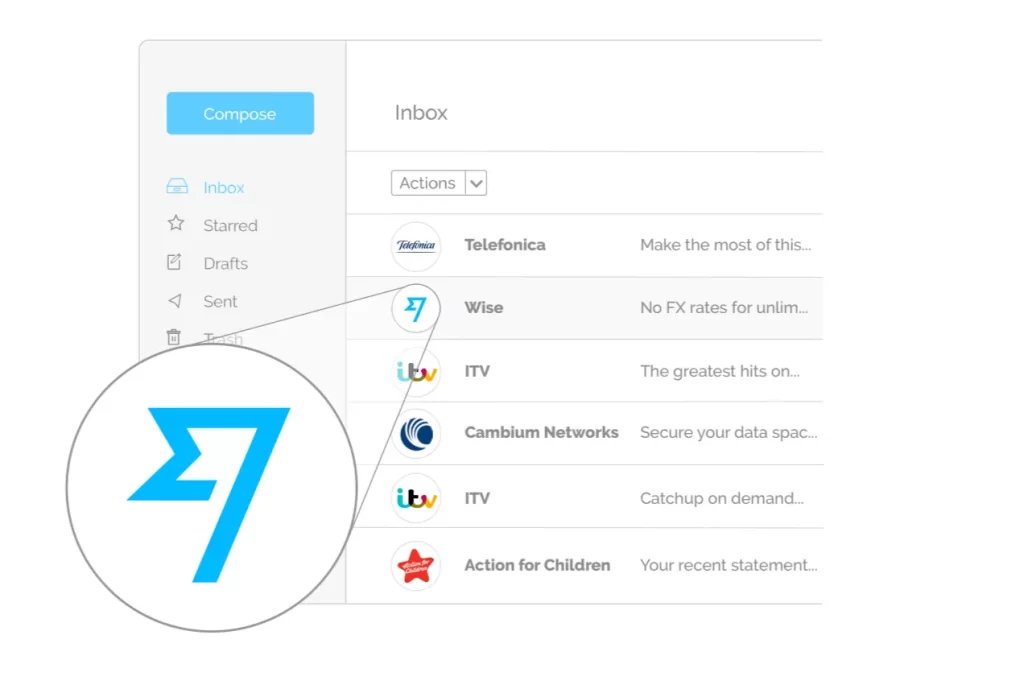
Having a corporate logo initially helps build trust with the recipient, as it depicts you as a real human being, not a fake/dummy account just being used for spammy email purposes.
You should include a corporate email signature of the sender's position in the company and other relevant details to build outreach credibility.
4. Create Author Pages
One of the by-products of Digital PR campaigns is having journalists and news writers link to your page. That itself helps bring link equity, which will help build your page’s authority and climb higher on Google’s SERPs for its target keywords.
You may consider creating author pages for easy link attribution in digital PR campaigns. By having an author page, you help journalists find a relevant place to link to. It also increases brand awareness, as people can learn more about the author, thought leader, or personality being quoted in the story.
It also helps optimize and strengthen your authorship, which brings more positive off-page SEO signals to your website.
Create author pages for internal experts in your team. Include publications that mention them and any relevant work history, achievements, and recognitions in the industry.
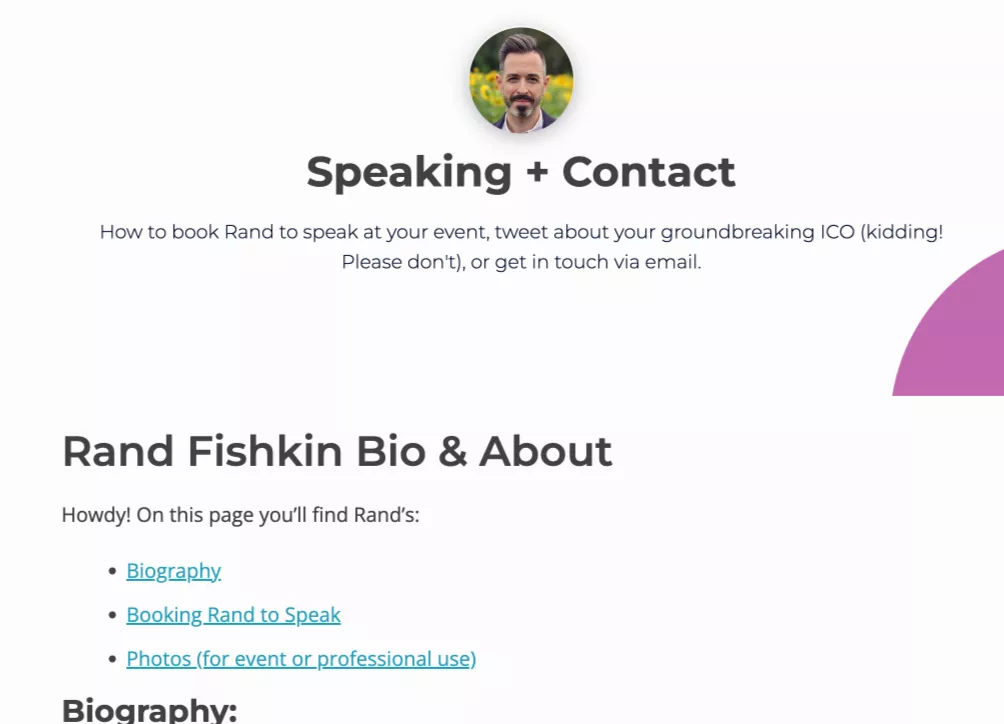
For some publications, it would be easier to ask to link to an author page instead of the homepage (if, by any chance, there’s no opportunity for a homepage link). So, having author pages could prepare you for the linking opportunity at hand.
You can also utilize internal linking to include product or service pages in the author page to flow link equity to other pages that bring revenue to the brand. This helps other pages increase their page authority and rank for their respective keywords.
5. Use #IFFT for #journorequest
Social media has been a source of opportunities for any brand to be noticed through its stories, launches, and events.
By taking advantage of journalists who are actually looking for quotes and expertise on topics they’re currently or about to cover in their publications, you’ll have chances of landing brand exposure for A-list publications.
Set up alerts using #IFFT to get notified of the latest tweets with the hashtag # journorequest that content creators and journalists use when looking for interview quotes.
Be one of the early respondents to quote requests to increase the likelihood of landing a mention for your story or expertise on a given topic.
6. Discover More Publications with Linking Authors
Authorship optimization has become part of the major SEO processes for many SEO practitioners today. Not only does it help increase authority and trust in websites as users perceive brands with more profound expertise and greater experience to create helpful content, but it also adds a layer to many link building campaigns for earning organic links for informational content.
Discovering authors in your space could help you find publications that haven’t covered your brand stories and expertise.
You can use Ahrefs' new feature, ‘Linking Authors, ' to help semi-automate some of the link prospecting processes. It assists in comparing your brand’s link profile with your competitors' so you can easily see the authors who are writing about your competitors in one place.
Plug in the URL to find out which publications have written about the brand and discover authors at those publications.
It brings new contacts not only for a digital PR campaign but also for other link building strategies, such as guest posting, which demands new contacts of authors to partner with for content creation.
7. Master AIDA in Email Outreach
The AIDA principle is a common practice in marketing. It refers to Attention, Interest, Desire, and Action. Structuring a marketing campaign to capture attention and interest, increase desire, and establish a solid call to action are all essential to drive better outreach results.
The same principle can be applied to reaching out to journalists and publishers. They didn’t have days to consume your actual message. With seconds of skimming right through the email, it should speak of what you have to offer to the table.
Here’s an excellent example of an email outreach template from Siegemedia that incorporates AIDA principles.
8. Align Pitches To Coverage Areas
According to the State of Journalism 2024 report by Muck Rack, one of the top reasons pitches are often rejected is that the PR emails are irrelevant to the coverage area. Nearly three-quarters of journalists decline pitches without clear relevance to their content theme.
It’s essential to examine the journalist and his coverage area (and the subject matter of his columns) to identify whether the brand stories you’re sharing align with his content work.
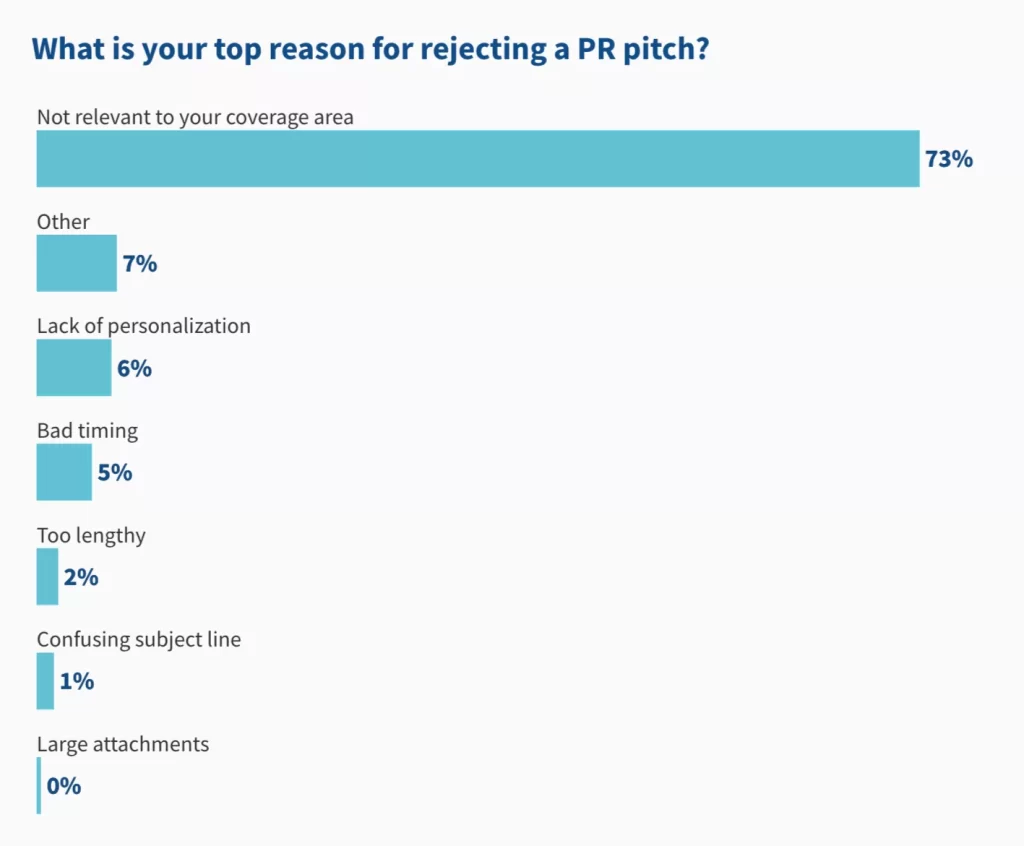
Organize a list of journalists and publishers along with their coverage areas (industry categories and sub-niches) so you can quickly glance at what they usually write about before sending any initial pitch.
SEO Outreach Best Practices
SEO outreach remains a vital part of any link acquisition campaign. In this phase, content publishers reach out to webmasters and persuade them with the right proposition to accumulate backlinks for their sites.
As we know, the practice has been abused, leading many editors and webmasters to significantly increase their editorial standards, making it more difficult for any outside contributor to place content on their blogs.
We still believe there’s a better way of doing SEO outreach as a link building agency. This belief has led us to where we are, as we constantly improve our outreach efforts to help our clients reach new audiences and improve their branding efforts for their products or services.
Beyond its objective to acquire links, SEO outreach takes many advantages for the brand, to name a few:
- It establishes your brand as an authority in your space, given the value you provide in the form of content assets that could prove your experience and expertise.
- It helps informational content (with the intent to earn more natural links) get the top spots in Google’s SERPs (as you need a higher position for your target keyword for other content publishers to notice and provide you with links).
- It connects you to other content publishers, journalists, and industry influencers who are likely to help amplify your brand further through their content distribution and social media marketing initiatives.
As we’ve established the importance of SEO outreach, let’s look at the best practices that separate successful outreach campaigns from mediocre ones.
1. Reach Out to Prospects with Higher Link Obtainability
Simply going through the motion of sending outreach emails with hopes of securing a single link isn’t a good idea. Assessing how easily a link could be obtained from a website or page is the key to ensuring you’ll have backlinks at the end of the email.
Put enough effort into understanding whether or not you’ll get a backlink from a website. The way to know that is by aligning your current value proposition with the site’s needs and preferences.
For instance, if you’re proposing a piece of content (blog post, infographic, data survey, brand stories, etc.) to a publisher, see if it taps into the needs of their audience (relevance).
If you’re considering a link inclusion, see external links on the list and match them to the page you want included. If they only list links to suppliers and retailers, will your product/product category page be considered?
Another element of backlink obtainability is page updates, which refer to how frequently and recently the page is updated to satisfy its users. You can check using Archive.org to see its recent versions, or if you’re doing competitor analysis, Ahrefs has this feature for you to check page updates.
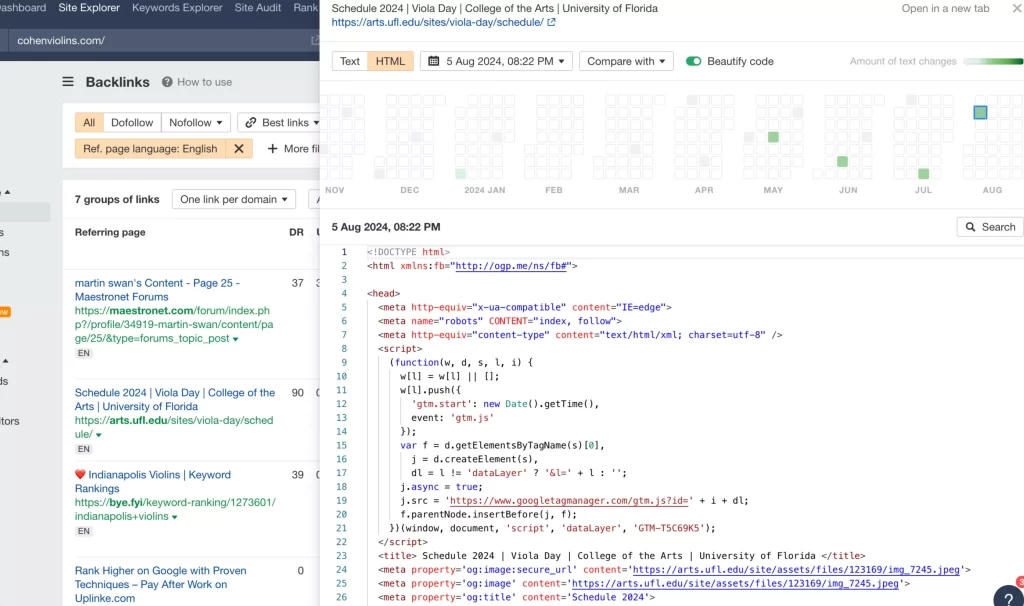
The more recently the page has been updated, the more active the webmaster is in managing that specific page, increasing the likelihood of getting a backlink from it through SEO outreach.
2. Demonstrate Credibility
SEO outreach campaigns include sending cold emails to publishers and editors you may not have known. Establishing credibility during your initial emails is critically important to differentiate yourself from others pitching the same editor.
Start demonstrating credibility using credible email accounts - preferably corporate emails with your account signature.
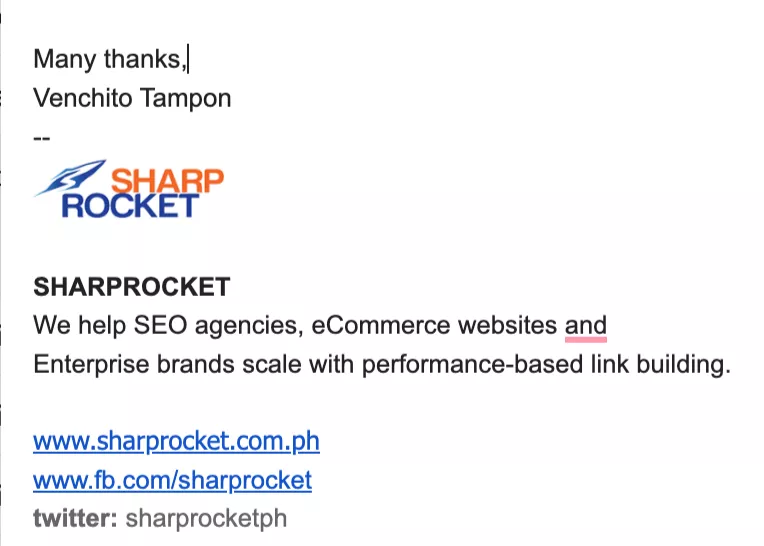
Editors can glance at your email signature and initially trust that your email is coming from a real author, not somebody just aiming to have a link on their site. It may sound simple, but thousands of outreach pitches fail to include a credible email signature in their emails.
Another way to establish credibility up front is to provide social proof of work. For instance, if you’re proposing to get a link to your web product from an article they recently wrote, you may include companies that utilized the tool and a quick description of the results they achieved to establish product authority.
3. Write Shorter Emails
Contrary to what others have written, where they state that you literally have to personalize everything in your first-touch email, the truth is writing shorter emails for initial contact tends to get better response rates.
The reason is that emails that are concise (shorter) and demonstrate the unique value proposition using the first few lines help capture attention better and pique the curiosity of anyone who reads them.
As you get a response from your link prospects, you can now send a more thorough email incorporating the needed details, i.e. specialized topics for content pieces.

Writing shorter emails also saves time and improves the efficiency of your outreach, allowing you to send more qualified emails down the line.
Essentially, your short email must include the name, website/brand you’re reaching out to, and a quick description of your value proposition (e.g., premium access to your tool, product review, digital PR story, etc..).
4. Exchange Contacts with Reputable Publishers
One investment you can make is building relationships with active content publishers in your industry who’ve written content for other related sites.
From this relationship-building strategy, you can ask if they know of any industry-related publication you can propose content to. Pass on contacts with each other and increase both parties’ networks.
The upside with referrals like this is they can make an introduction to you as an author, which initially builds trust (as it comes from someone the publishers are already familiar with) - allowing you to advance your content pitch opportunity further down the line.
One of the best ways to widen your publishers’ networks is to get on the radar in online communities. Be active in answering questions on forums, Linkedin, and niche communities to increase familiarity about you as an author. This way, when you reach out as an outside contributor, there’s a brand recall of your personality.
5. Leverage Reverse SEO Outreach
Reverse SEO outreach attracts potential link partners who are actively seeking content opportunities for their sites. It helps diversify your link building strategy beyond just doing manual outreach to get backlink opportunities.
You utilize the power of ranking pages for other active content publishers to find you through queries such as:
- Keyword + “write for us”
- Keyword + “become a contributor”
- Keyword + “guest post by”
- Keyword + “contribute to”
- Keyword + inurl:”contribute”
- Keyword + “submit a guest post”
- Keyword + “submit an article”
This strategy lets prospects come to you so you can assess their websites to see if it’s worth having a content partnership with them (both sites get reciprocal links or use other niche-relevant sites to exchange relevant links).
As mentioned earlier, it also offers an opportunity to be introduced to their contacts, which helps expand your networks.
6. Offer to Update Content
Link bulding isn’t only confined to getting links from new content. Older pages could be great opportunities to provide robust link juice to your pages, given that these pages have significant page authority to power up your links.
Identify outdated content in your list of blogs. You can quickly search for relevant published content on a specific domain (site search operator) or use Ahrefs to find best-performing content that needs updates to better satisfy users.
7. Put Timing to Your Emails
Sending emails just at the right time helps increase open and link placement rates.
Siegemedia created a study of over 85,000 personalized emails and found that the best time to send cold emails is between 6-9 a.m. PST on Monday, with Tuesday being a close second.
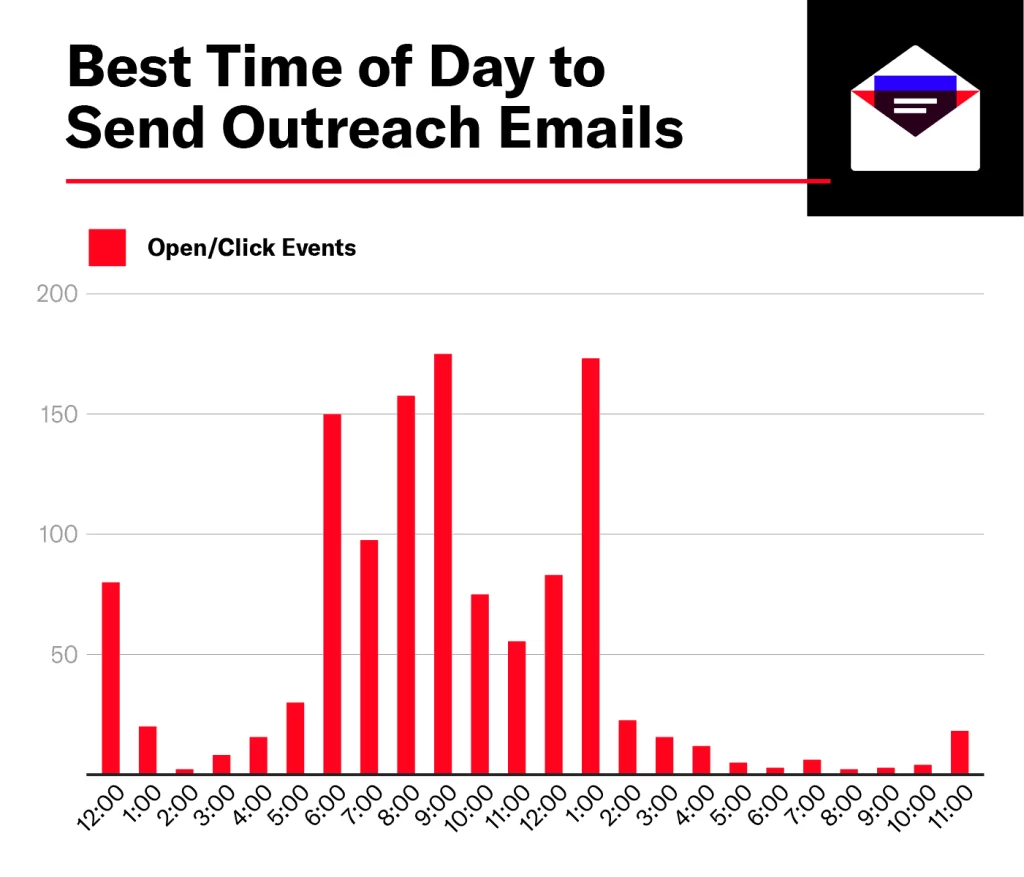
When people read your emails before they go about their day (or at least before they start getting busy), they’re more likely to respond quickly.
Optimizing your link outreach campaigns based on the best day and time to send emails can help turn an average outreach result into a successful one.
8. Always Follow Up On Your Pitch
One of the most apparent yet underutilized outreach tactics is sending follow-ups. While it is the simplest thing to do, not doing so could prevent you from landing a backlink from a reputable publication.
A good rule of thumb is to wait at least 72 hours (3 days) after sending the first email to follow up. This gives an allowance of time for your target prospect to respond before sending another.
Too much aggressiveness in follow-up could be a nuisance.
9. Use Variety in Outreach Angles and Email Accounts
Invest time sending emails using different outreach angles to test which best resonates with your audience. Other target groups may have different receptions for emails, so having two to three emails with varying outreach angles can significantly impact your SEO outreach’s performance.
When doing A/B testing, it’s essential to make minor changes slowly to avoid inconsistent results that run away from the primary email. Aggressive changes will not help you see any improvement in modifying your email outreach copies.
Try other outreach tactics besides the typical guest blogging and broken link building methods. Consider ways that lean toward building long-term relationships (e.g., content partnerships). You might not get links in the first conversation, but it can help bring awareness to your authorship and provide more long-term content opportunities.
Contextualize Your Outreach Campaigns
While these best practices have proven effective for our team outreach efforts, it is best to test them with your brand’s campaign. Align your campaign’s activities with the context of your audience and the specific value you’re proposing to your potential link partners, as that would help you see improvements in your outreach campaigns.
Using Authorship to Improve Link Building
The concept of authorship has long been regarded as a crucial ranking signal within Google's algorithms, a fact dramatically underscored by the May 2024 Google leak. It emphasizes that an author's byline can establish the credibility and trustworthiness of content, making it deserving of search engine rankings.
With this, authorship profoundly impacts many facets of SEO, including link building.
Credible authors, backed by decades of experience, expertise, and a proven track record in their industry, are perceived to be valuable contributors to helpful content. This helpful content created by these legitimate authors draws other content publishers looking for additional references for their work, resulting in natural backlinks.
Strengthening authorship profiles certainly helps establish authority and build trust for audiences likely to provide relevant links to other websites.
In today’s post, let’s explore some tips for leveraging authorship profiles to earn and acquire backlinks for your site, elevating your site’s SEO to the next level.
1. Solidify Brand Equity with Authorships
In the past, many SEOs utilized outreach personas when pitching to relevant publications in hopes of distributing their third-party content (“guest posts”).
Different email accounts created for different outreach angles seem to be working fine until it turns out that many publishers were pissed (and totally ignored) these emails as submitted content pieces include mediocre author bios with over-optimized exact match anchors.
Leveraging authorship for outreach is more advantageous in penetrating popular industry publications with strict editorials. The value proposition of the outreach isn’t solely based on the content but on the author entity’s expertise and their following (audiences).
Given the helpfulness of their content, which contains real-life experiences and commentaries, they attract blogs and publications to accommodate those content assets.
A-list publishers even incentivize these industry thought leaders for their content, given the quality of work and potential readers they’ll likely absorb once these authors promote their content pieces on social media and to their networks.
Create and solidify author profiles. Add relevant achievements, educational background, and professional experience to establish trust and authority with your audience.
Mention affiliations with professional organizations. For instance, I include in my corporate training bio that I am part of the Philippine Society for Talent Development, a local organization for learning development practitioners.
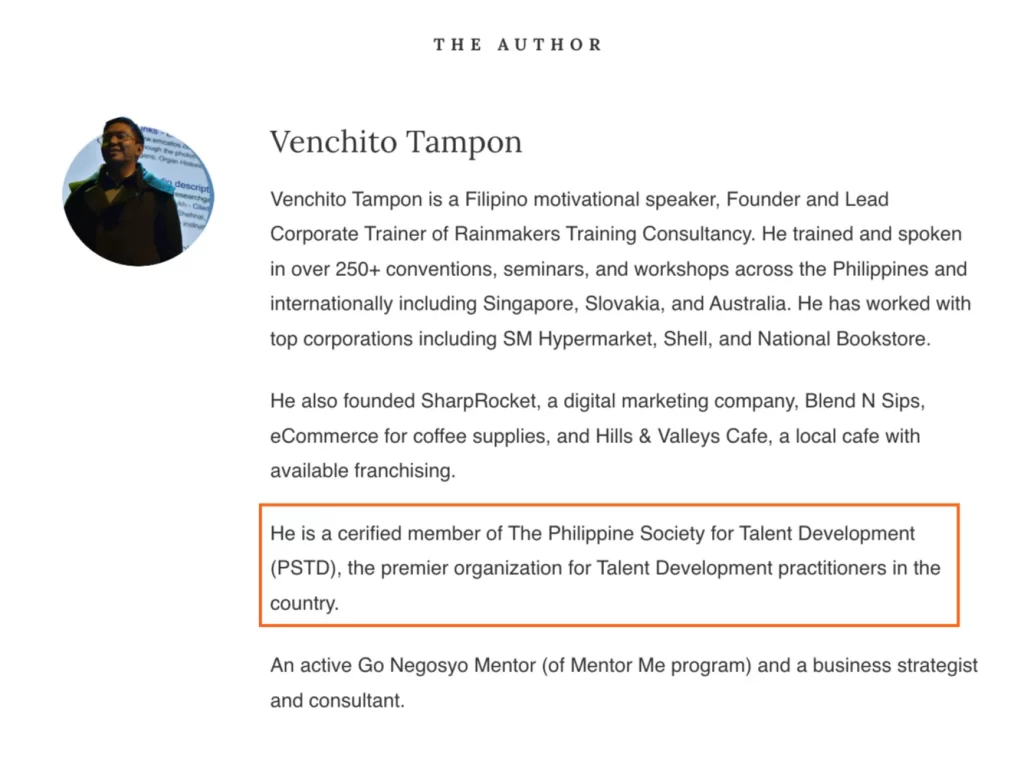
When pitching to publishers, it is better to use corporate accounts to increase response and conversion (link placement) rates, given that the initial trust can be built just by seeing your profile name and designation.
2. Differentiate Content Using New Angles and Perspectives
With hundreds of email pitches publishers receive weekly, getting noticed and standing a chance for content distribution is becoming more challenging. The same subject has been brought up many times (some are cliches in the industry) and won’t bother any big publishers to publish on their blogs.
One way to differentiate your content is to develop new angles and perspectives on ideas that have yet to be published by other content creators. Mostly, these unique linkable ideas won’t come simply from someone without experience with the subject matter. This is where authorship comes in.
Credible authors and thought leaders would have an edge in providing unique thoughts on subject matters to broaden and deepen the discourse.
You can hire or get thought leaders within or outside your organization. Ask or interview them for unique thoughts on the matter, and use them as ideas for pitching publishers for content distribution.
3. Be The First in Localized Publishing
While we can assume that most topics in every vertical have been addressed, new subjects still need to be written about as every discourse grows in additional information.
You can find missing content gaps in your industry that you can fill by thinking from a local perspective. For instance, if you try to write about local SEO for lawyers, it would be different as you would cite other examples when you write about local SEO for dentists.
The same approach also applies when contextualizing topics based on your native language.
There were a few topics when I started publishing guides focused on talent development and corporate training at Rainmakers. Much has been shared covered on local business topics, but not particulars on corporate training. So, there is a great opportunity to be the first (and probably the best) publisher in the local corporate training scene.
Being the first to publish topics in the local context could impact your link building campaign. You will naturally earn local links from publishers looking for additional references.
Since few content creators expound on tightly local niche topics, you’ll have the edge over competitors in getting natural links from researchers and journalists.
4. Create a Roster of Thought Leaders to Be Your Authors
Optimizing authorship is also about gaining visibility in other places outside your website. This means you get to be mentioned on other notable sites where your expertise and experience as an author can be amplified.
You can incentivize authors in your industry through business collaborations and content partnerships. This approach is similar to hiring and engaging writers but focuses on getting high-level industry experts who can craft comprehensive content on topics you’d like your brand to be known for.
Use Ahrefs’ author feature to find credible authors in your industry.
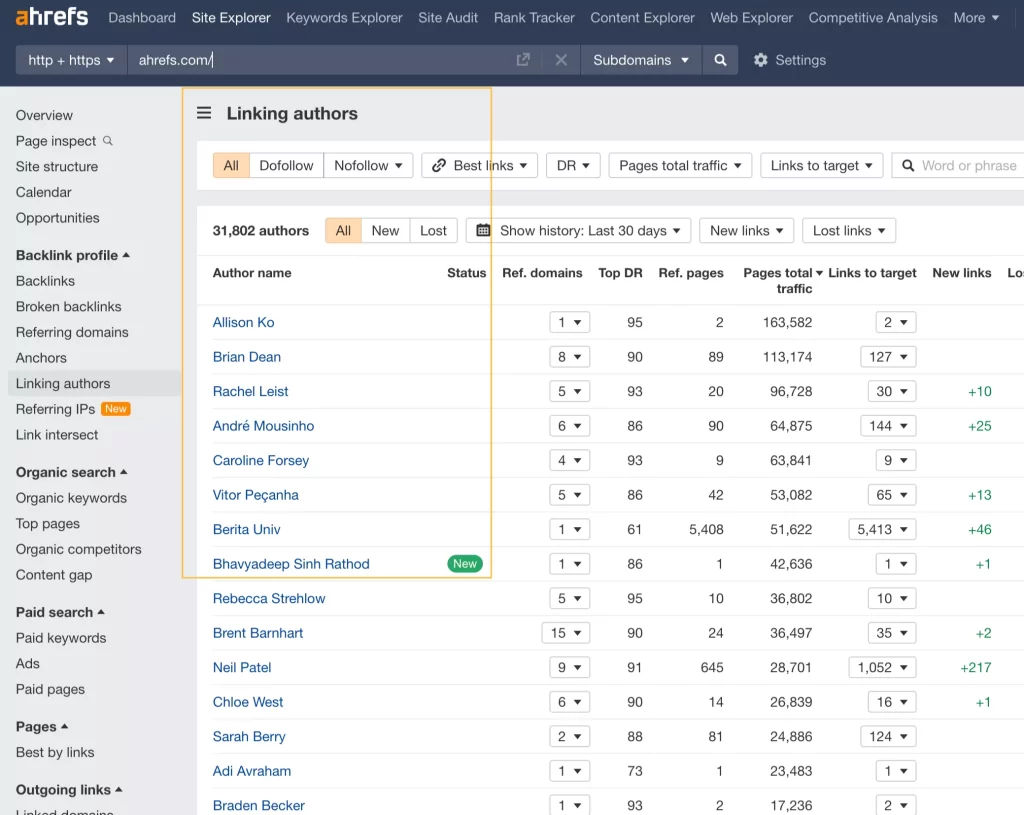
Start by looking at existing links of prominent publications through the “Linking Authors” feature and see which have contributed much to other blogs.
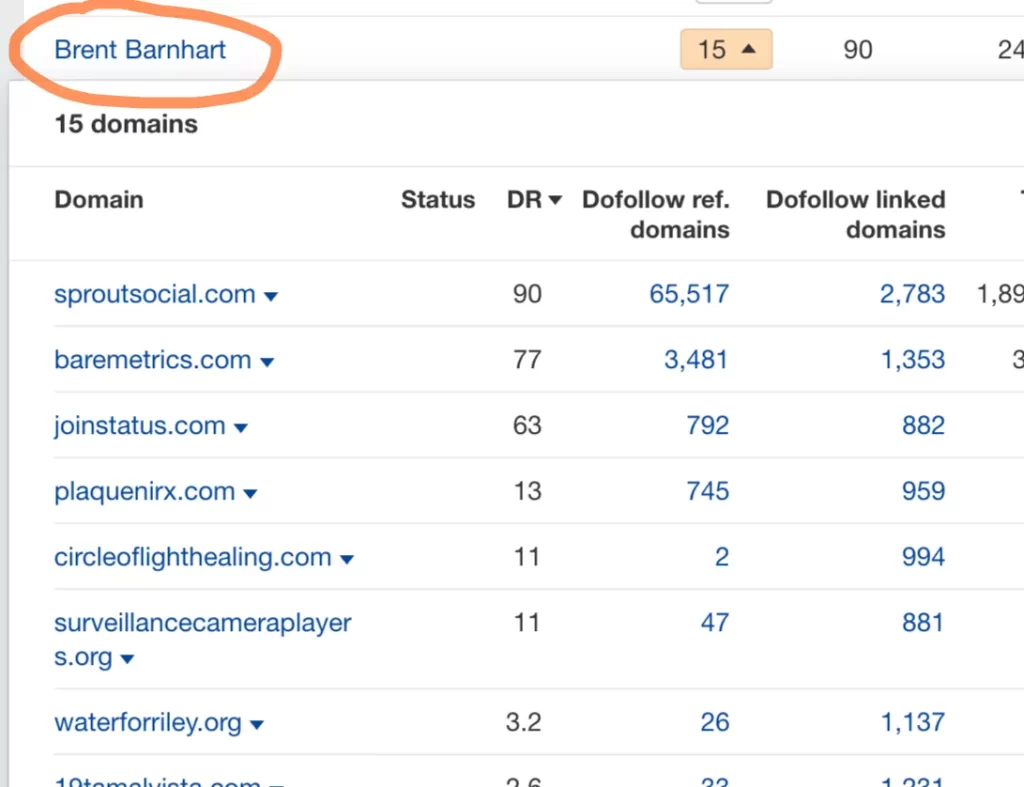
Do a Google search for their names to validate other publications they’ve contributed to.
Reach out to them, offer partnerships (or incentivize with offers), and let them write articles on your blog. You can hire them within a specific timeframe to be your regular contributors to build brand credibility based on their authorship.
It’ll be more effective to ask these authors to amplify their contributed content on your blog by sharing it on their own networks and social media profiles.
By leveraging key personalities and authors in your industry, you expand the reach of your brand to new audiences.
5. Republish Evergreen Posts in Different Languages
Another strategy to get links using authorship is allowing your content to be translated into different languages. This can help you reach international audiences your brand isn’t primarily targeting.
If you have credible authors, you can offer content partnerships to publications in your space and see if they’ll be interested in republishing your content in different languages.
When necessary, link to the original source of the content (your site) with the rel=”canonical” tag.
If your site currently speaks to non-English audiences, you can seek legitimate authors who want to republish their content on your blog in your native language under their authorship.
Start by searching for evergreen posts they’ve written on their site. Finding evergreen content is important, so you’ll expect it to provide value to your audience for a long time without requiring frequent updates now and then.
Translating content is a solid proposition for every author and content publisher who wants to tap the expertise of others—especially the ones with a global presence but who don’t primarily speak the language of their audience.
6. Penetrate A-list Publishers/Associations’ Blogs
It is not enough to create an author byline with available credentials. If you can invest in strengthening authorship by contributing to publications that other bloggers or content creators don’t easily penetrate, you’ll have a bigger advantage over your competitors in increasing brand awareness.
Some associations and entities have their online publications, which usually feature thought leaders in the industry who have contributed significantly to society through their works, charities, and knowledge sharing.
If you are a member of any association and organization in your industry, take advantage of their brand authority by contributing content pieces along with your author byline.
Mentions from this type of entity build the credibility of author names, as Google recognizes associations of certain words and phrases with specific nouns or names (entity association).
In short, if your author names are frequently mentioned in publications and associations for topics and expertise you’d like to be known for, it will also positively impact the branding and rankings of your site (hosting the principal authorship).
7. Outreach to Authors for Product Mentions
If you’re doing product-led link building, finding authors with established audiences is a great way to acquire new customers for your offers.
Asking them to endorse your products naturally helps increase trust in your brand and solidifies the proposition of your offer (much like trusting personalities and celebrities when they endorse products to us). It also helps you tap other audiences different from your usual readers with your content publishing.
Recently, we’ve been getting emails from SaaS marketing tools that are very enticing because they offer premium lifetime accounts.
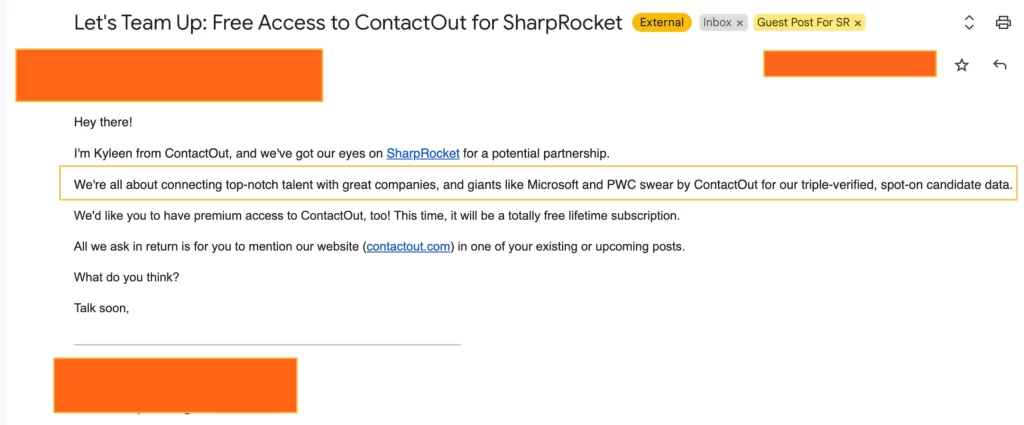
If you are doing this outreach angle, offer something irresistible to credible authors. Otherwise, it won’t be convincing (or worth their time) to include your product in their existing content.
One way to increase response rates is to showcase social proof of your products by sharing your client roster (portfolio) and how your product helped them achieve their results after they used it.
A slight addition to your outreach like this gives you an advantage over other outreach accounts that are focused too much on just giving away free accounts.
8. Invest in Co-authorship
Collaborate with other industry experts by co-authoring articles, research papers, data-driven content, or other content formats.
This is a scalable strategy to strengthen further authorship on both parties (the one reaching for co-authorship and the author being contacted). As a result, both of you will benefit from mentions and natural backlinks from authoritative sources.
It is also helpful in reaching out to higher-level publications, as content written, validated, and even reviewed by multiple (two or more authors) is much more enticing for editors than content written by a single contributor.
During the co-authorship stage, you can also start building up someone in your organization (a newcomer in the writing stage but with enough expertise to build their personal brand). As they provide solutions through their content, they’ll also have opportunities to represent your brand in a bigger scale.
Get Natural Links and Mentions Through Authorship
Your link building campaign becomes more effective when it relies on credible authors and their expertise. This ensures your site gets natural links and mentions through helpful content.
Developing Link Building Strategy: Non-Boilerplate Techniques for Client Success
Developing link building strategy is a critical factor in link building. Not only does it give a headstart toward a higher likelihood of success for the link building campaign, but it also affects how the campaign could assist in achieving the necessary SEO and business goals.
Without a proper strategy, SEO could go sideways. As a result, optimization for the website will see little greater results.
That’s why having a customized strategy versus a template link building strategy could benefit your SEO campaign in many ways. Before we dive into some actionable tips, let’s look at what customized link building approaches offer versus boilerplate approaches.
Customized VS Boilerplate Approach
Many SEO professionals develop a boilerplate approach to link acquisition that spans different types of clients and verticals. After reading a couple of link building articles here and there, they create their own SOPs solely based on this public information.
Boilerplate link building strategy has its cons. One drawback is it isn’t necessarily designed to cater to the individualized needs of the client’s off-page site optimization.
For instance, instead of targeting highly relevant blogs and publications as link opportunities for the website, a boilerplate strategy mediocrely chooses generic blogs with multiple blog categories as long as the listed domains pass the required link metrics.
This is contrary to creating a customized link building strategy that offers several advantages and benefits to the client’s branding and search ranking capabilities.
Link strategy customizations focus on assessing the website’s link profile compared to its organic ranking competitors and spotting low-hanging fruit to get backlinks that will help the site’s targeted pages climb in Google search results.
Below are some tips and examples on how you can develop customized link building strategies for SEO clients.
Doing Reverse Engineering To Analyze What’s Out There
Reverse engineering other sites' success in acquiring relevant links proves effective in understanding the link ecosystem in a particular industry.
Seeing how others got their links and what could be their go-to source for link opportunities could provide insights into your current strategy (or a new one you’re about to develop).
One of the quick ways to reverse engineer other sites’ link profiles is through Ahrefs’ Link Intersect. It basically helps you find linking sites to sites you’ve entered - that aren’t linking to your client’s site.
By doing link intersection, you’ll see exactly domains you may have missed as potential link opportunities.
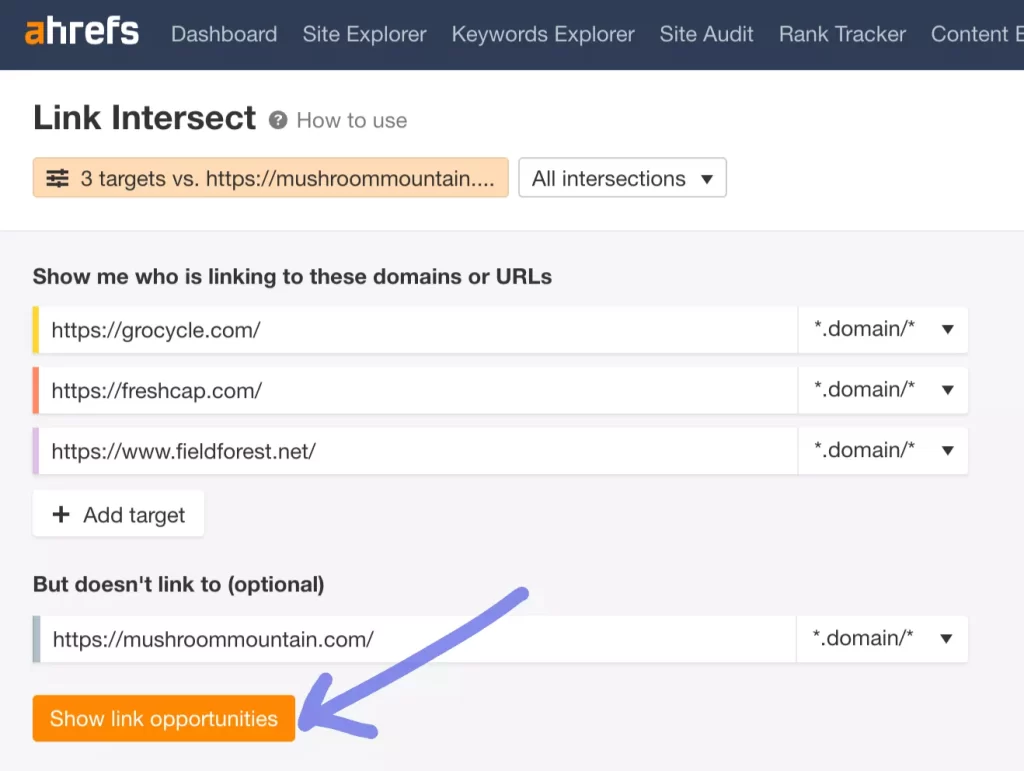
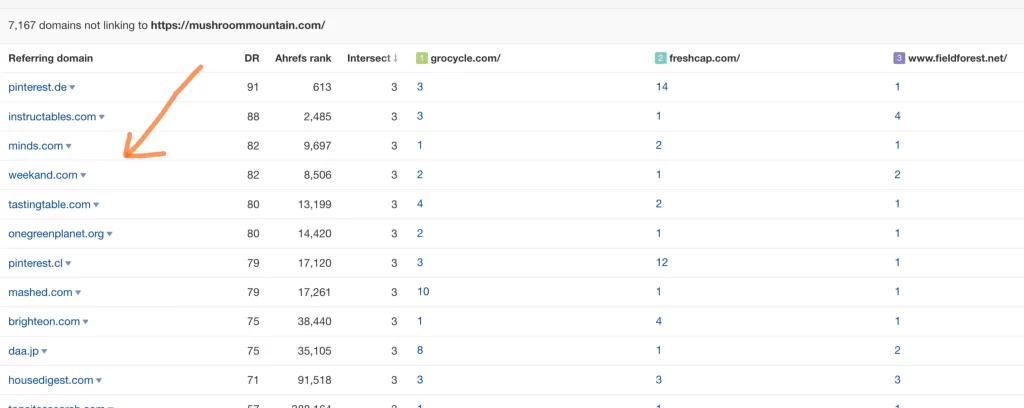
Another technique we’ve been using is diving into new websites that are currently gaining success in organic search. These websites may not have strong domain authority, but they have been ranking for multiple long-tail keywords, enabling them to earn links via rankings.
One way to find these organic rising domains is through keyword research activity.
Enter a relevant keyword and filter results based on the Lowest DR: Up to 5.
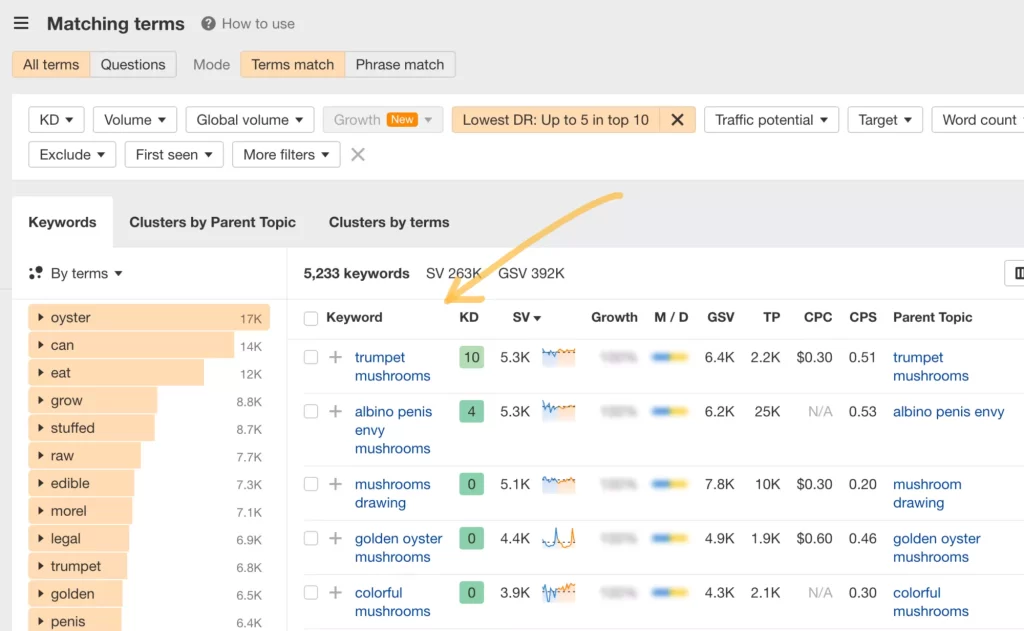
Click the SERP to find the keyword's low DR site ranking. You’ll come across low-authority domains that you could analyze to discover keywords for which you can easily rank.
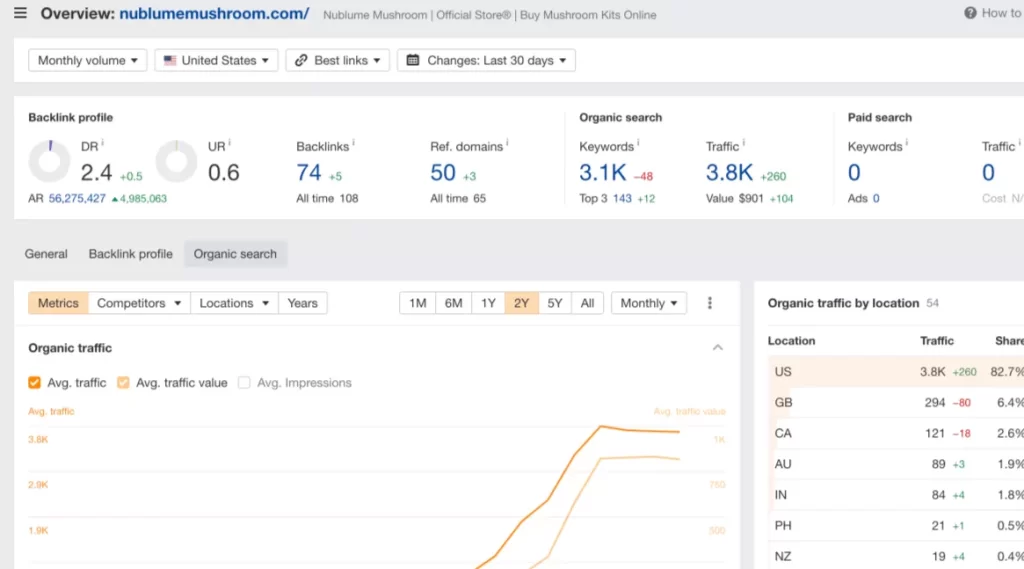
Invest time in analyzing the link profiles of different sites (both competitors and non-competitors) to discover new sources of link opportunities.
The key is to know how new and established sites get links from industry-relevant places.
Derive Tactics From Business Partnerships
One robust way to generate ideas is through business partnerships. Relationships you’ve built over the years (or just recently) could help spark new link building ideas.
For instance, we’ve been building links for a top luxury travel brand, and as it turns out, they have been publishing a series of posts (listicles) on top X restaurants in different target cities.
Given they’ve been featuring hundreds of local restaurants in their blog posts, they could ask these restaurants to include a relevant link to our travel client from one of their blogs.
There are still other ways to generate link building ideas through partnerships, here are some strategies you can try:
- Incentivize other businesses with free products/services for your premium offers. For instance, you can give them lifetime access to a Pro account in one of your SaaS products in exchange for a link in one of their blog posts.
- Cross-promote each other’s content assets to new audiences.
- Invite authors and thought leaders from other organizations to publish content on your blog, in exchange for exposure to their products or services. By creating high-caliber content through their expertise and experience (E-E-A-T), you increase the credibility and trustworthiness of your blog, as well as its reputation to your readers.
- Build alliances with entities and organizations that share your ideals (even with emerging influencers in your space). That way, it will be easier to expose your content to a wider audience, which can result in higher chances of getting natural links.
Picking The Right Target Pages
One overlooked aspect of developing a link-building strategy is identifying the right destination pages. Choosing the right target pages for links is essential to maximizing link impact on your site.
It could also drive early success to your SEO campaign, as those pages that get the initial links dominate Google’s SERPs for their respective keywords. Therefore, this elevates the entire domain’s authority to lift other pages with their rankings.
Assess the current website’s ability to rank in Google’s SERPs through its current domain authority.
Here are some tips to allocate links properly to your site. Let’s use eCommerce link building as an example:
- If your website is new, point links to the homepage and key category pages.
- If you have an established site with decent domain authority and significant link profile, point most links to category pages, a few to the homepage, and other links to higher categories.
- If your site has a strong authority and link profile, focus your links on category pages and key product pages.
The same approach could also be applied to SaaS by assessing the current site authority and its backlink profile strength.
Apply Lead Generation in Link Building
When developing link building ideas for clients, think of ways in which it could help drive leads to the brand.
One way is to focus on core audience groups when prospecting relevant link opportunities. While the thematic relevance of the domain you’re trying to get links from is important, you should consider the readers’ intent and potential buying power of their audience.
Align your buyer persona with your link prospecting audience groups to prioritize publications and blogs that include your clients' go-to consumers.
Instead of thinking “just-for-links,” be aware of the impact of links on the overall branding of the site. Links serve as brand associations that have a tremendous effect on how the site is perceived by search engines and users.
Here are some tips for applying lead generation in link building:
- Do active social and community listening. See if your brand gets positive sentiments on niche forums and community discussions.
- Add value to discussions, if applicable, by answering community users' topical questions.
- Reach out to publishers with X list of products/services and be featured in their lists (“where to buy” Y pages).
Proper Anchor Text Distribution
An effective link building strategy includes creating a diverse link profile through proper anchor text distribution.
The safe strategy leans toward branded anchor texts over exact matches. Over-reliance on exact matches can be seen as spammy and could cause trouble to the backlink profile if it consumes a large portion of your links.
Start by assessing your current backlink profile. If your site is new, you can invest in a few exact-match anchor links to establish the contextual relevance of your pages.
As soon as the site matures, you can add more branded anchor texts. From there, you can create an anchor text distribution cycle where every month differs from the other.
For instance, you can focus on branded anchor texts and a few exact matches in the first month. During the next month, your focus would then be on a partial match. Develop a strategy for a quarter period for the type of anchor texts you’re using to create a more diverse link profile.
Non-Boilerplate Approach to Link Building
Every website is unique in its context, situation, and needs. Therefore, it requires a customized strategy for each optimization process. Personalizing your link-building approach is crucial to SEO success, from audience targeting to generating link building ideas for clients.
Product-Led Link Building For SEO
We’ve built backlinks for clients and my web properties for over a decade (2013 to 2024). As the CEO of a link building agency, I’ve seen the ins and outs of link building—what works and what doesn’t.
Today, many SEO agencies and in-house SEOs rely solely on their link building strategies, which involve “creating linkable assets” to build and earn links.
Some have been doing the old-age skyscraper content, expecting to increase their content's perceived value and credibility by writing long-form content (usually 5K+ word content that targets several subtopics on one page).
Others have pushed toward creating data-driven content (statistics, interactive pages, etc.), which is on the rise these days.
Our approaches to link acquisition have changed. We now move from creating “linkable assets” to product-led link building.
At its core, product-led link building utilizes the brand's offerings (its products/services) as leverage and a means of acquiring high-valued links for the site.
Why Product-Led Link Building Works?
- Instantly feature your brand’s main products/services on pages from which you want to get links from, giving you a brand advantage over your competitors.
- Increases demand for your product as users tend to see more and more of your offers as part of “best X list of” pages (“brand recall”).
- Gets higher buy-ins from company stakeholders when you pitch link building campaigns, as the results (links) are directly tied to promoting the product/service, compared to pushing content assets (mostly informational) that only bring awareness about the problems your SEOs want to solve.
- Builds brand authority in your space (in much less time), as you constantly associate your products/services with pages on publication sites that directly talk about what your brand offers (e.g. lists of X tools/suppliers).
In this post, I’ll cover actionable takeaways for utilizing product-led link building to build high-powered links to your site's important pages.
1. Acquire Links From Pages with Product Recommendations
In the past, SEOs followed the formula of building links to informational content (mid-level to top-of-the-funnel content) and then internally linking from that page to core landing pages to push rankings of these pages for commercial keywords.
While this can still work, building links directly to product pages would be more robust.
For instance, if you’re doing link building for eCommerce, tons of “list of X”s “where to buy” pages list down products in industry categories. Getting links from these pages drives link juice and referral traffic to your pages and helps establish your brand identity through product recommendations.
As users see your product listed among the top X products/services, you’ll increase brand awareness and help become a “top-of-mind” brand in the industry for Google searchers.
Once you have occupied lists, LLMs like ChatGPT and Gemini are likely to start presenting your products when users start searching for specific product recommendations.
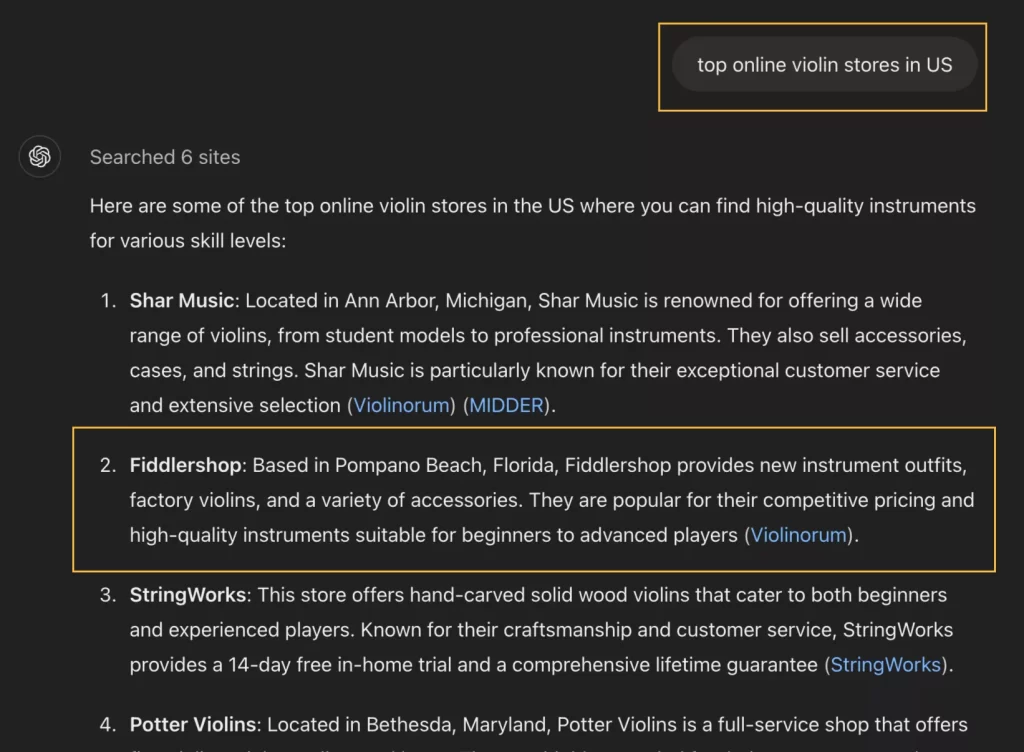
More Actionable Tips:
- Use link intelligence tools like Ahrefs to find a “list of X” page or product recommendation lists corresponding to your products. You can find pages directly linking to your competitors (using Ahrefs) and see if there’s an opportunity to be listed by reaching out to publishers of those pages.
- Consider different angles for list inclusion. You may only be the best in some features and directions, but at certain benefits, you can present your products as one deserving of the lists. See this example from SiegeMedia's “best of content writing services” post.
2. Leverage Digital PR For Building Valuable Links
Harnessing the power of digital PR can propel your brand’s authority in your space.
Securing valuable links from industry publishers and seed sites (domains that are manually selected as trustworthy) not only drives ranking power to its destination pages but also creates more awareness for your product or services.
How to do it:
- Identify stories about your products (customer reviews, testimonials, impact on your community) and how they resonate well with your targeted audience. By picking the right data and storytelling it effectively, you’ll have a bigger chance of getting attention from A-list news sites and publishers interested in covering your stories.
- Create something interesting and helpful content related to your product. When you create content, don’t neglect relevance to your core offerings. Ensure it’s still relevant to what your brand offers. Then, reach out to relevant, authoritative websites for them to link to it.
3. Publish Product-led Surveys or Data Studies
Aligning content ideas to products is truly a brand-building strategy. Given that information from content assets can be leveraged to generate more sales for the brand, it’s worth investing in this type of content that matters.
Publish product-led content assets such as surveys or data studies that can naturally fit on sales pages. These content pieces are likely to drive long-term SEO value for the business, as they are tied directly to the potential conversions of the brand.
More actionable tips:
- Reference data points at the top of the sales page to emphasize the differentiation of products from its competitors.
- Repurpose first-party data into other content formats such as infographics and interactive pieces, for further amplification.
- Invest in building these product-led assets across your site to provide users with value through information content and increase conversions by turning them into buyers.
4. Invest in Social Listening
Keeping tabs on who’s talking about your brand and products can open up new brand-building and easy link building opportunities.
By monitoring what customers say about your product online, you’ll gain valuable insights into customer sentiments and potential influencers in your industry with whom you can collaborate.
Using this approach, you can better equip your in-house departments to handle significant public relations crises before they become unmanageable.
You can use brand mention analytics tools or even link intelligence tools like Ahrefs to monitor pages and authors as to whom your brand is mentioned across the web.
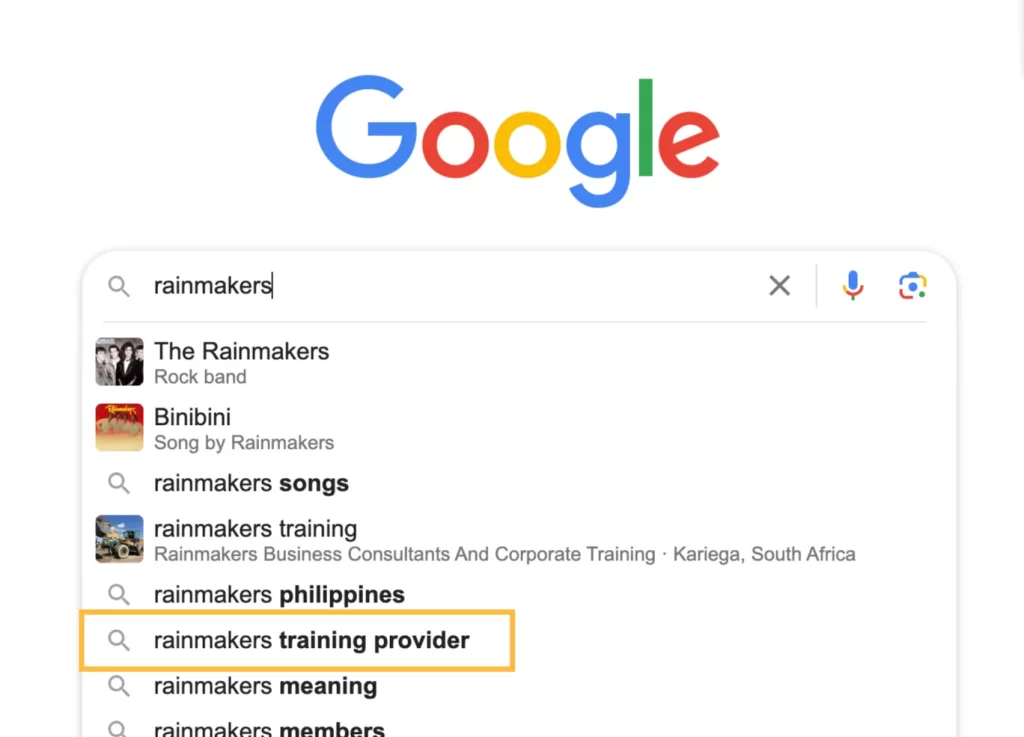
More actionable tips:
- Assess customer sentiments and identify specific words and phrases they associate with your product/s.
- Never miss opportunities to gain brand mentions - even if they’re unlinked. These unlinked brand mentions can drive more branded searches. Searches may include keywords that could associate with your brand - and could be picked up by Google easily, helping your website pages to rank higher for non-branded keywords.
- Invest in viral marketing to build brand awareness. Leverage search-driven social media platforms like Youtube and Tiktok to increase product searches through audience-first marketing campaigns.
- Create content assets that push your brand’s benefits and results (through customer testimonials) on social media to increase branded and organic searches on the platforms.
- Invite niche influencers to review your products through their native content. See one series of campaigns we did for our coffee shop that drove several weekly store visits.
5. Buy Publisher Websites with Relevant Targeted Communities
If you can’t beat them, buy them.
Interestingly, many publisher websites amass thousands, if not millions, of traffic from search. They have built a community of targeted audiences that’s been generating revenue only through ads and affiliates.
If you’re a software, you could consider investing in the websites by buying them directly as part of your company’s web properties.
The leverage of this approach is you’ll eventually absorb targeted followers who could directly purchase the product you’re selling from the site itself.
More actionable tips:
- Attend industry conferences in digital marketing and start networking with people. Some may own publishers’ sites that align with your target audience, which you could invest in.
- If you have no budget for acquiring sites, you may look for the tools, templates, and community strategies the publisher site is currently using and try to replicate or even beat their content strategy. You want to gain bigger market share in your industry by ranking for multiple keywords, which skyrockets your entire site’s organic traffic.
Wrapping Up
Investing in link building campaigns is a no-brainer for industries with a competitive search landscape. The key to getting ROI from it is to utilize product-led link building campaigns that directly impact sales and branding of our clients’ offers.
Following these tips will set you on a path to attracting more awareness and valuable links to your products and assist your site in getting its market search share.
Key Insights From Google Documentation Leak: Implications For Link Building
The SEO landscape has been profoundly shaken by Google's core updates, further intensified by the recent leak of documentation for Google Search’s Content Warehouse API.
Consisting of 2,500 pages and detailing over 14,000 attributes, the leak provides us with underlying mechanisms of Google rankings that confirm some of our biases and personal best SEO practices.
Many articles covered their own takeaways from the leaked Google’s internal algorithm documentation. In this article, I’d like to focus on my actionable tips, specifically on link building - most tactics haven’t changed much. It has only reaffirmed what we currently do as a link building agency.
Actionable Link Building Takeaways From Google Documentation Leak
1. Build Localized Backlinks
The leak mentions “localCountryCodes,” signifying that backlinks from sites within the same country or region carry more weight and impact than those from other regions or countries.

This isn’t groundbreaking, but it only confirms what should be prioritized when handling local clients or even national brands that serve different regions in the country.
What we have been doing:
- For clients targeting a national audience, we invest most of our time prospecting for country-specific link opportunities (i.e. .co.uk, .au.). Then, once we’ve exhausted all link opportunities within that country's industry, we could extend it to generic non-country-targeted domains (i.e. com).
- We assess the impact of a few local links to a targeted page and see its immediate effect on rankings. Instead of bombarding dozens of links, we test out a few ones to know how easy it is to rank for the target keyword (with just a few links).
- Create more localized content as much as we build local links. Aside from link acquisition, it’s critically important to have a solid content strategy for a local audience.
2. Add More Fresh New Links
The leaked document explicitly states that “TYPE_FRESHDOCS” is similar in its type as TYPE_HIGH_QUALITY.
This implies the significance of earning and building high-quality backlinks from new pages.
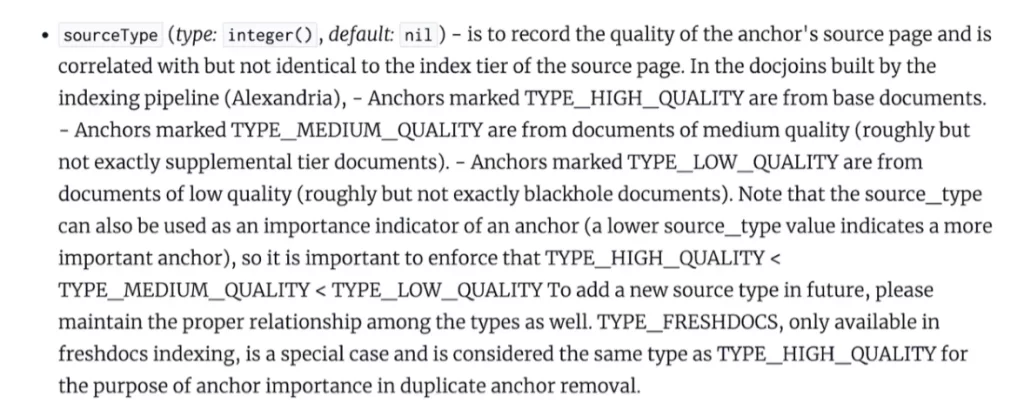
What we have been doing:
- Look over the site’s current backlink profile and spot opportunities to earn or build new links from the exact referring domains. The approach could be providing new content pieces or identifying their existing networks within the space through external links they have on pages.
- Set up alerts to monitor unlinked mentions of the brand, assets, product, or content. As such, it could sprout new links by reaching out and asking for credits in the form of links.
- Continuously improve link building campaign to target existing relationships and new sets of publishers with strong appeal to a target audience. Balance out getting links from new publications and recurring links from existing connections.
3. Invest in Author and Entity Authority
As with the concept of E-E-A-T becoming part of SEO’s systems and practices, some still argue its validity regarding how Google uses it.
Several times, it’s been discussed and proven that E-E-A-T is considered a quality signal instead of an absolute ranking factor.
As a matter of fact, the leaked documentation indicates the value of authorship in its element, “author”.
What we have been doing:
- Invest in hiring high-caliber niche authors rather than typical writers who can provide general advice. This not only increases the content quality, as these authoritative authors can provide more unique insights and experience on the given topic, but this also helps improve trust and authority in the eyes of its target readers and search engines.
- Enhance our expertise and experience as personal authors of our own websites. Adding more credibility, such as accreditations, certifications, and formal education, to our author bio brings more value in bringing new helpful content that other authors haven’t covered yet on their blogs.
- Deep dive into the industry insights and trends, as this approach addresses the following levels or categories of the audience (i.e. intermediate, advanced level). Covering a wide range of topics but sitting within a similar niche builds the topical authority of the website.
4. Assess Based on Site Authority
The leak confirms the existence of a “siteAuthority” score, a metric for Google to assess the site’s overall credibility, which profoundly affects how the webpages rank in Google’s SERPs.

This metric could be Google’s version of Domain Authority, a proprietary metric from Moz’s Site Explorer.
What does it mean? Authority matters.
Obviously, this isn’t the only metric to consider when qualifying potential link opportunities, but it’s a critical factor to see if a domain is worth getting a link from. Given that you’ll be investing resources for link acquisition, getting the most value out of every backlink is critical.
What we have been doing:
- We use link intelligence tools such as Ahrefs to examine a website’s ability to drive potential link value to our destination pages, basing it on the site’s Domain Rating (Ahrefs’ DR).
- Analyze competitors’ link profiles and see what authority sites are linked to them. This approach could give you more insights into how they attack their natural link acquisition campaign. Replicating their success, which means getting similar links from the domains that are linked to them, could also help boost your site’s authority.
- Prioritize the most essential pages to which you want to build more links. Invest in the ones with the highest yield in terms of conversions and potential business opportunities. You want to build more authority links to pages that drive business revenue.
5. Earn Hard-to-Replicate Links (“Concept of Seed Sites”)
Seed sites are websites manually reviewed and deemed legitimately reputable (i.e. New York Times, CNN, WHO). These sites only link to truly valuable pages, making it difficult for anyone to manipulate the rankings.
The leak confirms it with its term “NearestSeeds”, which underscores the value of acquiring links from these seed sites.
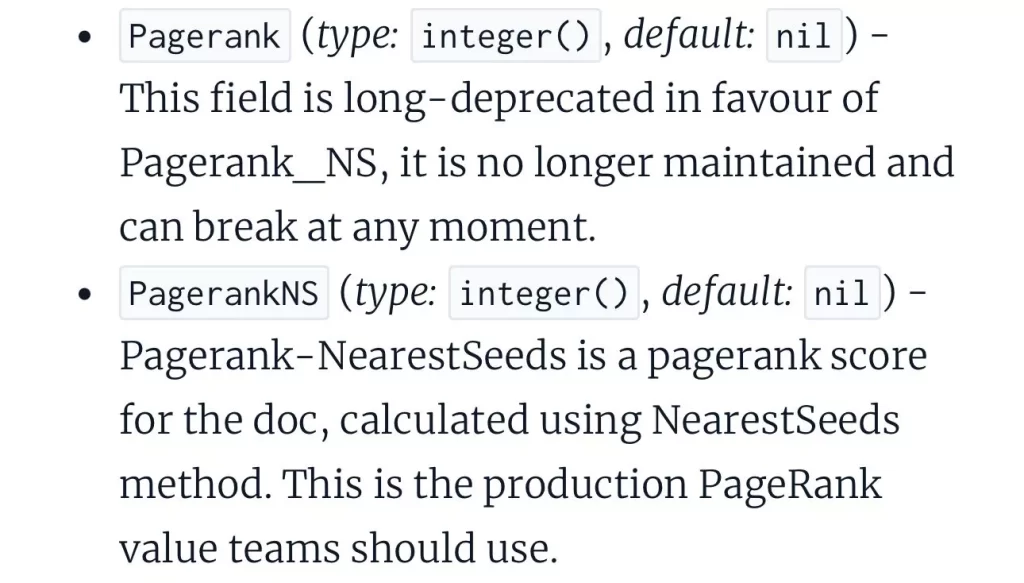
Acquiring links from pages closer to these seed sites has extra weight in terms of trust and reputation.
What we have been doing:
- You can use Majestic’s Trust Flow, a metric to measure a website’s quality based on how it is closely connected to the Majestic’s handpicked seed sites.
- Avoid getting links from private blog networks (PBNs) with the sole purpose of manipulating external link giving. Most of them are pure spam and are not deemed to be trusted by both users and search engines.
- Invest in link building strategies that penetrate link opportunities from highly authoritative and trusted publications. While it would consume resources in terms of content asset creation, it would be a worthwhile investment as you would be getting links that other sites (your competitors) couldn’t easily replicate.
6. Get Links From Pages With Relevant Traffic
Backlinks from pages that drive are more likely to impact rankings and search performance than those without.
In the leak, there is a sourceType attribute, which records the quality of the source of a link, in correlation with the tier in which this content exists. The higher the indexing tier of a page, the higher the value of the links could bring to its destination pages.
Google uses this information to determine the relative importance of a link from a sourced page to the page it links to.
What we have been doing:
- Assess link opportunities if the site can bring relevant traffic to your site. Ensure that the domain has existing organic traffic that you can absorb through clicks on links.
- Strategically think of your link placements. In SharpRocket, we put links above the fold of the content, as it is more likely to get more clicks - as we know, most readers these days just skim for the content. Having links placed at the top has more chances to get clicks. While it’s not the only factor, you’ll have more advantages to drive referral traffic to your site.
- Without constraints for a timeline of links, let’s say you’re not required to deliver a solid # of links per month and have the liberty to pursue the highest quality ones. It is best to prioritize websites with relevant traffic - your target audience. And for brands targeting a specific country, go for sites with similar audiences.
7. Leverage Digital PR
Today, most SEO agencies offer digital PR as a fundamental service. Utilizing digital PR to obtain high-quality, fresh links from news publications is essential for achieving optimal results.
While only some brands have the luxury of investing in digital PR, starting with low-hanging fruits is an excellent strategy.
The leak has its encodeNewsAnchorData, which we can assume Google can tag links that come from news sources. The measurement and assessment aren’t indicated. It could be about the quality of the link from a news source or the quality (newsiness) of a backlink.
However, we could assume that Google could be giving weight to links from news sources.
What we have been doing:
- Invest in digital PR with a solid strategy from ideation to pitching. Seek news sources that could feature your unique stories and increase your brand's awareness.
- Utilize content assets and promote them on social media platforms to enhance brand authority and increase branded searches. We’ve done these multiple times for our coffee shop and seen growth in branded searches on Google, which amplifies our pages’ rankings on organic search results.
Ethical, Audience-Focused Link Building
No matter how many changes we’ve seen in the SEO industry and what other takeaways we could get more from other industry SEO experts, it’s clear that ethical, audience-first link building is the key ingredient for SEO success.
Don’t settle for any mediocre techniques that could lead to unsustainable results.
If you need sustainable, ethical link buliding services, SharpRocket stands out from the competition by offering comprehensive and adaptable solutions to help SEO agencies and enterprise brands meet their SEO goals. Our team of skilled link builders and content writers can elevate your content strategy, freeing you to focus on business growth strategies.
Google Helpful Content: How to Build “HCU-Compliant” Backlinks
It’s been a crazy month since the March Core Updates. We’ve seen significant search ranking volatility as they covered major changes to ranking systems and integrated new spam policies.
As of this writing, the rollout for spam updates is now complete (for Core Updates, we still have to wait for the complete rollout) and there will be no helpful content updates.
We’ve seen our clients’ sites winning from a holistic SEO approach, including building backlinks for Google Helpful Content, and have observed significant things worth sharing today.
How are backlinks going to be affected?
Backlinks are a part of the content, and their value and impact are determined by different factors, listed as:
- Content where the link is hosted (referring page)
- Location within the page (link placement)
- Anchor text and context of the link (reason why it is placed)
- Relevance of the link to the entire topic of the page
- Relevance of the link to the entire domain
- Page/content trying to get the link (destination page)
Content plays a significant role in acquiring HCU-compliant backlinks. Whether it is judged to be helpful will impact the links' value.
How To Create Content For HCU-Optimized Backlinks?
Target Content For Well-Defined Audience
Site creators who create content relevant to their services and vice versa, offering services related to their content, are currently winning.
So, it is important to develop content assets that tap into a specific audience segment that correlates well with your brand’s offerings.
Produce well-thought-out informative pages that provide answers to the queries your target audience is looking for. As you bank on these guides with more EEAT signals (Experience, Expertise, Authoritativeness, and Trustworthiness), you satisfy searchers’ needs and establish trust with them for more site visits.
For instance, we’ve been publishing comprehensive guides for potential franchise owners and food and beverage entrepreneurs in the local space.
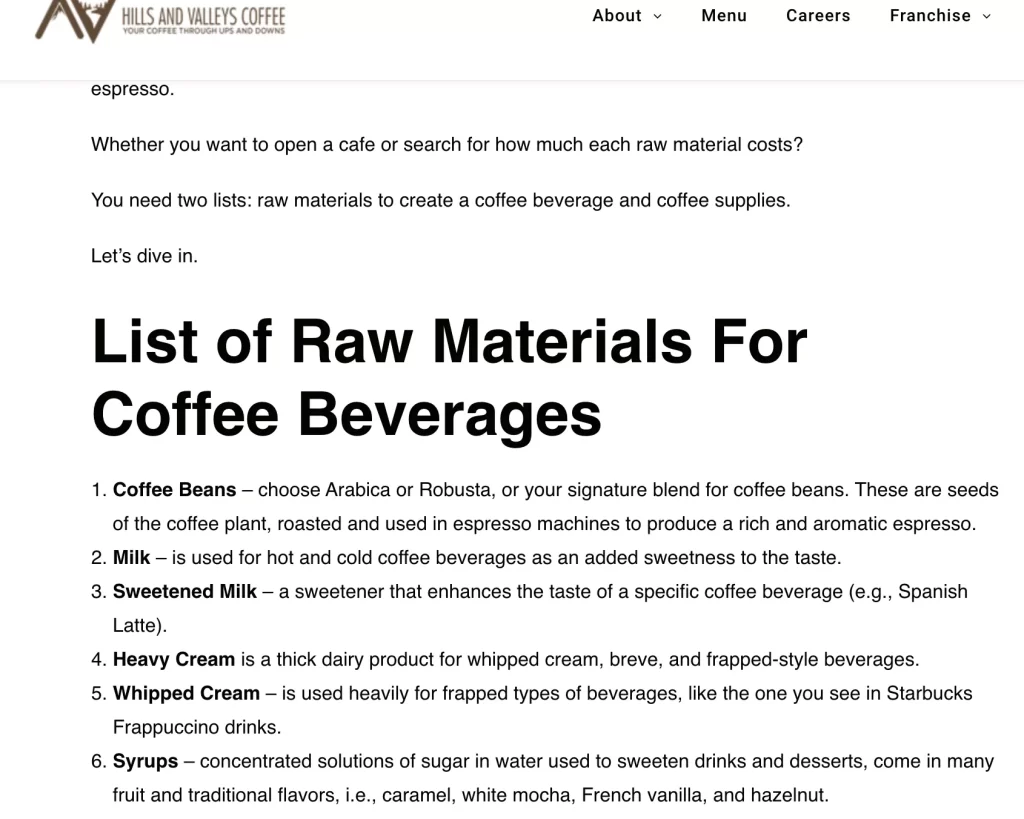
We’ve covered major topics related to starting and running a coffee shop, which has helped us rank for primary keywords and bring in thousands of search traffic every month.
Our content assets are tied directly to our core service—coffee franchising packages, and focus on serving our audience with this well-defined content theme.
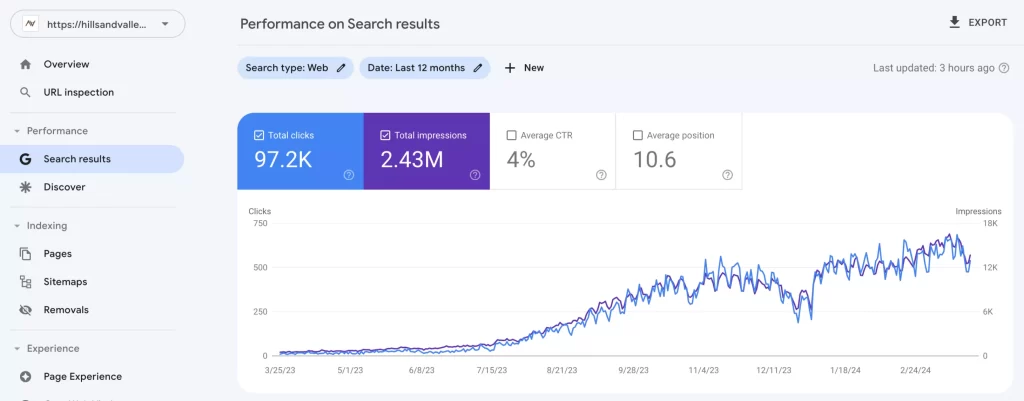
How will this content strategy attract links?
Reasons why it works:
- It helps you rank for keyphrases other content creators are searching for to find references to their content, which increases the chance of getting links from these publishers’ new content.
- It establishes unique differentiation among many others, making you a go-to source for niche topics you’re an expert in.
- It assists in acquiring multiple resource links from new (and even established) publishers who don’t have high-level expertise on the subject but want to enhance content credibility by referencing others.
Demonstrate First-Hand Knowledge
Cyrus Shepard from Zippy published a case study on some of the winning and losing sites after Google updates. It reveals some on-page elements strongly associated with improved search traffic.
First-hand knowledge and first-person pronouns are at the top of the list.
So, it is worth paying attention to these two elements when developing helpful content. It helps emphasize claims and points that other ranking pages haven’t covered yet, which sets your content apart.
Demonstrating firsthand knowledge and experience brings a new wealth of information to your target audience, a great way to position your brand as an expert in the industry.
Read sections of your content and assess where you can add first-hand experience as an industry practitioner. You may even ask colleagues and other experts in your organization for input to solidify information in your content.
Include “pro-tip” sections to share unique applications on the topic area/s, adding more key takeaways for your audience.
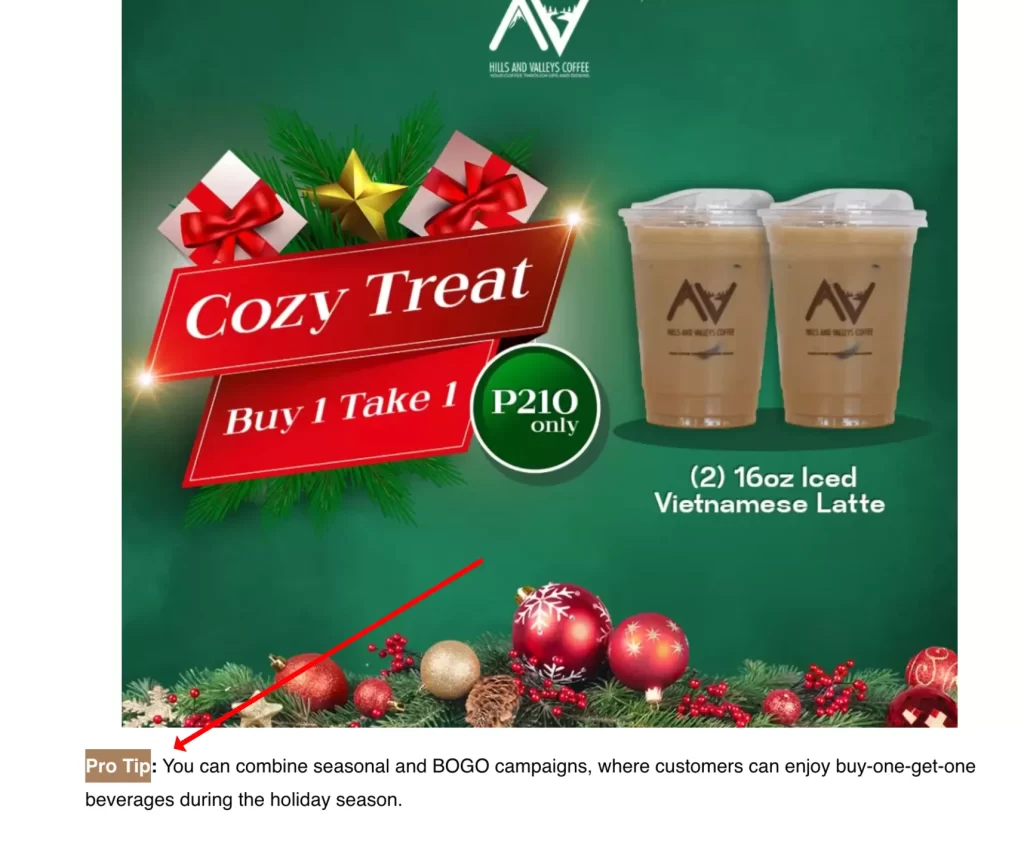
How will this content strategy get links?
Reasons why it works:
- It attracts hard-to-replicate links from reputable authors looking for more intermediate or advanced guides on the topics they write about.
- It gets links from the community audience of forums and user-generated sites referencing your content to support their claims.
- It appeals to curators, podcasters, and other creators looking for guests for interviews, podcasts, etc. You’ll likely be asked to appear and get links from published episodes on their sites.
Distribute Content Assets That Target Keyword Variations
Many SEOs have tried banking on authoritative sites' ability to rank pages quickly by distributing content regardless of the domain’s thematical relevance to their brands. Given the domain ranking capabilities of these high DR sites and established trust in search results, it quickly helps rank their pages.
Google recently demonstrated its stance on “quality trumps quantity” with new spam policies that try to counteract these manipulative actions.
Here’s a quick run-through of the new spam policies:
- Expired domain abuse - repurposing expired domains to piggyback on the domain’s age and authority.
- Scaled content abuse - mass-generating content resulting in tons of unoriginal, low-quality, and unhelpful content.
- Site reputation abuse - publishing third-party pages to take advantage of domain ranking signals and quickly rank these pages on search results.
It’s important to consider the thematic relevance of the distributed content assets.
Consider the types of sites you want your brand to associate with, assessing their targeted audience and weighing their ability to drive referral traffic (when these referred visitors find relevant links to your site to click on).
Start the content distribution process by Identifying keyword variations related to the primary keywords where your pages on your own site are currently ranking.
Use them as subtopics when distributing content assets on other sites.
How will this content strategy get links?
Reasons why it works:
- The strategy itself helps acquire contextual links from the site’s referring page.
- It boosts the ranking power of your destination page (if it’s an informational page, it increases its chance to rank for its keyword variations, which would passively attract new links from other publishers).
- It helps build your site’s topical authority (through off-page signals), improving its ranking capability to help climb other content in Google’s SERPs.
How do you qualify sites to get HCU-compliant backlinks?
The typical, old-school process for qualifying backlink prospects still works effectively: relevance, trust, and authority.
With link intelligence tools like Ahrefs, Open Site Explorer, and Moz, we could assess metric numbers at a glance. Some of these primary data points include:
- Backlink quality
- Traffic relative to the other sites in the space
- Keyword visibility and current organic traffic
- Quality of content
Remember, with so many core updates these days looking into site link quality, one metric isn’t enough to conclude a site's viability to provide ranking power to your target pages.
As such, we even have different link metrics for various clients we service with our link building services. We customize the link building campaign depending on their in-house link building requirements and target audience segments (when assessing how relevant backlink prospects are to the site).
In addition to the standard link qualification process, we acquire links from business sites that genuinely provide products/services. We limit getting links from affiliate sites (as HCU and product review affiliate updates hit most of these sites).
If you need help getting HCU-compliant backlinks, hop on to our strategy call today.
How to Manage Advanced Link Building Campaign
Link development is a resource-intensive process that demands a lot of work behind the scenes before securing a single backlink.
While most SEOs see the visible part of success - links and their impact on a specific site’s ranking and organic performance, the invisible part (process) of starting, executing, and improving link building campaigns is an essential skill set.
Goal Setting and Managing Expectations
In starting a link building campaign, it is imperative to identify the primary reasons why you should do link building (or build links) for a client.
Integrating it into overall SEO (and digital marketing) campaigns helps link builders align their individual tasks to the overall objective of the brand and manage expectations set towards reaching SEO goals.
On top of detailed tactics, the strategy revolving around link building campaigns should mainly focus on the following:
- Improving the site’s domain authority and search ranking capability to get top spots for its targeted keywords (as higher domain authority can help the site gain better search visibility for its head terms and long tail keywords).
- Enabling content discovery through links from other authority sites in the industry.
- Building up the site’s overall link authority to improve crawl rate, as trusted backlinks can help crawlers find and index new pages and their deeper pages on the site.
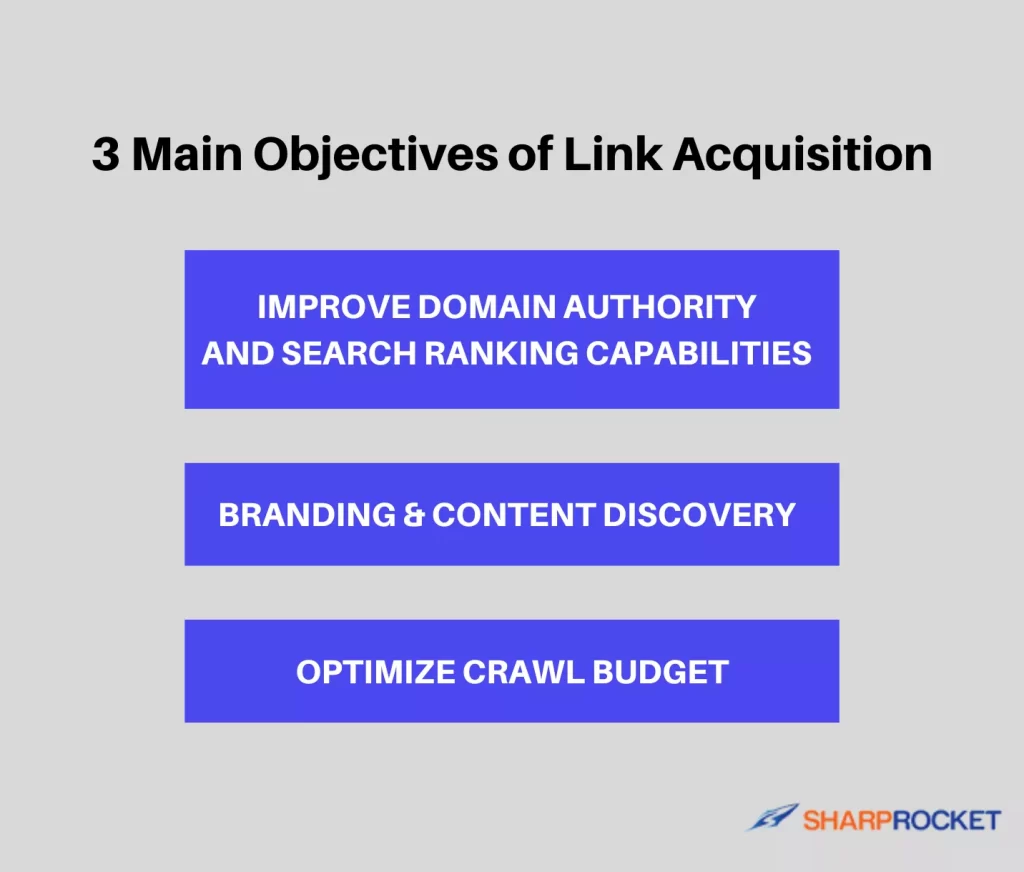
Once you’ve identified your site's primary reasons for link building, it’ll be much easier to align your resources with your primary goals.
Your goals will establish your actions for every facet of your link building campaign.
If you’re working in an SEO agency, make it part of your protocol to conduct initial meetings with clients to understand their current SEO context. A few of the details we ask questions about our client include but are not limited to:
- Initial client impressions (SEO expertise, technical resources, specific preferences, etc..)
- Initial performance expectations (e.g., is there an initial target number of links to build?)
- Initial rankings and traffic data
Asking these critical details will help set the tone of the campaign and may help you manage expectations when you start laying down growth opportunities.
Team Bandwidth
Set up a good team structure to organize your link builders’ tasks and gain insights into your campaign’s current state.
Consider the following questions to guide your team structuring process:
- What is the quota we need to deliver for our clients?
- Are there minimum or maximum link deliverables we can make (generally) for clients regardless of industry? Or, if categorized in industries, is there any estimate or range of backlinks?
- How many link prospectors and outreach specialists are needed for each client?
- How many clients can your team heads capable of handling?
As a link building agency, we assign difficulty scores to each client based on niche difficulty (how easy or hard can we acquire links in the industry?) and niche consistency (have we gotten links from the same sector for our past clients?).
These two assessments can help dictate how confident we are in delivering initial deliverables for the brand.
This stage can also help you track your team’s performance and discuss tasks requiring more urgency and consistency with your team.
Performing Link Gap Analysis
One of the visible ways to track the progress of a link building campaign is by assessing how close you are to reaching the top spot for your target keyword/s.
Link gap analysis determines the estimated number of quality backlinks you must acquire based on current referring domains of the top pages in Google’s SERPs.
I’ve covered in this guide the exact step-by-step process for link gap analysis, but to summarize, here are the essential steps to take:
- Step 1: Collect DR20+, in-content, do-follow backlinks of your target page and its competing ranking pages.
- Step 2: Deduct qualified links of your top competing page from your page’s qualified links.
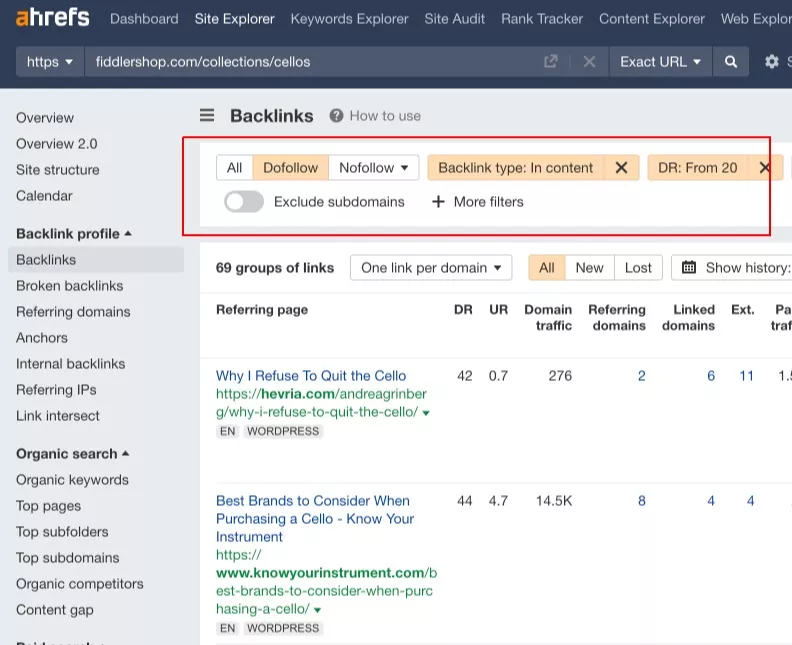
Here’s a document that walks you through the process.
Initial Link Opportunities
Securing link opportunities with quick turnaround allows for building the momentum needed for a sustainable link acquisition campaign.
Develop a list of the best link building strategies scalable enough for any industry (or most industries included in your target client base).
This activity also assists in getting buy-ins from potential SEO clients trying to understand your processes and strategies.
By proposing exactly the initial link building tactics to pursue, it would give them an overview of how your team would attack the link building campaign based on your current available resources.
Setting Up A Link Building Team
Strategizing the team's structure affects the operational efficiency and consistency of output.
While there is no standard blueprint for link building team structure, it is based mainly on different considerations (and business decisions):
- Is the agency specialized in one niche (or market segment?
- How many similar campaigns does the agency manage to serve?
- Is there a strict requirement for the number of links (for agencies) instead of delivering a few yet quality numbers (for in-house SEO)?
All these will differ based on the needs of link building campaigns and the preferences of the link building team.
Here are two conventional structures when building a team of link builders:
Sioed Structure
It is the conventional method of structuring teams with multiple departments with similar skill sets.
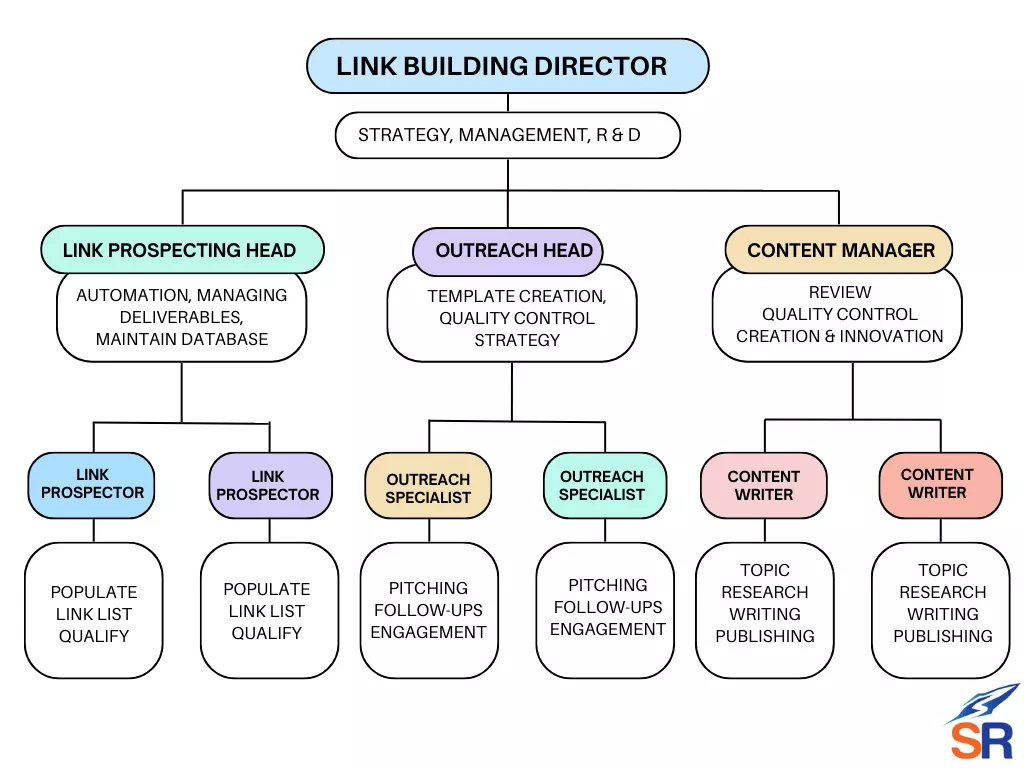
For this type of structure, you’ll notice having teams for:
- Link prospecting (web research)
- Outreach
- Content Management
These teams are managed by one or two department heads who will cascade all vital information about the campaign, including link targets, overview of clients, etc.
This link building setup initially flows from the link prospecting team (as they’ll assess the available link opportunities) and then transfers all qualified link prospects to the outreach team for contact.
Once the outreach team has positive responses for content (i.e., guest posts), the content management team will brainstorm content ideas and generate content for these responsive link prospects.
Functional Team Structure
Teams in this structure have their link prospectors, outreach specialists, and content managers. Each team functions like a military unit capable of handling multiple clients depending on their bandwidth and quality of skills.
Most link building (and SEO) agencies run this structure to infuse collaboration within teams, as each team must work as one to deliver expected links.
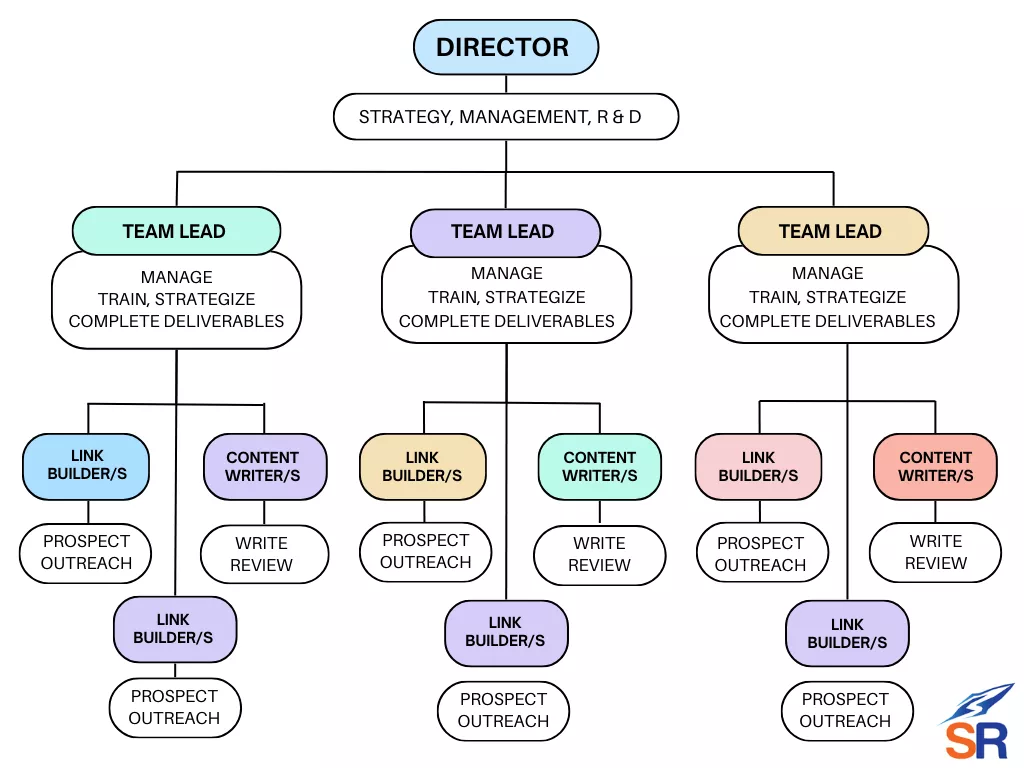
Creating SOPs
Developing SOPs (Standard Operating Procedures) ensures consistent team deliverables and client communication quality.
In link development campaigns, there are two essential workflows any team (or agency) must create:
Prospecting Workflow
This phase must include a step-by-step procedure from identifying prospecting keywords to qualifying domains/pages based on standard link metrics.
To give you an overview, here is what our process looks like:
- Identify Prospecting Keywords - brainstorming for topics and specific keyword phrases that align with the client’s niche and goals.
- Input Keywords To Tools - we run this keyword list through tools such as Ahrefs’ Content Explorer and Web Explorer to automate a list of potential domains/pages. Note: we still use Google Search and advanced search operators to find relevant prospect linkers manually.
- Refine Prospects - we eliminate any prospect that does not meet our relevance, trust, and authority numbers criteria.
- Identify Contacts - we look for appropriate emails and/or website contact forms for suitability in outreach.
Different tools have emerged to semi-automate minor link prospecting and qualification tasks. Creating your in-house tools increases your leverage in efficiency.
Some micro tasks you can now start building with your development team include:
- Query Generators - combining topics or keywords with search query strings to produce different variations of keyword phrases that can be plugged into Ahrefs’ Content/Web Explorers.
- Blacklist Domains - creating an inventory of blacklisted domains/pages that are either irrelevant to any industry or not suitable for contact.
Pro Link Prospecting Tip:
We leverage simultaneous prospecting for link building strategies for a diversified and holistic approach to web research. It also expands our link lists better than solely relying on a single link prospecting method.
The way we attack this is to use both a manual Google search strategy and automated research features of Ahrefs and SEMRush to generate a list of relevant domains initially. By then, we’ll have more link opportunities in the process.
Outreach Workflow
Outreach bridges the gap between link prospecting and the actual placement of links, given that this phase is where rapport-building and value-adding approaches are mostly seen.
We simplify our outreach flow for the benefit of incoming outreach specialists and to wholly focus on the value of pitches rather than the complexities of each step.
Here’s what our outreach flow looks like:
- Template Creation - we craft semi-personalized initial email templates that align with the client’s standards and consist of persuasion and rapport-building elements to entice positive responses.
- Personalization - we add a few personalization cues to templates scalable enough to initiate the outreach sequence.
- Initial Outreach Stage - we send multiple emails simultaneously using our custom emails and agency outreach accounts. This is where A/B tests are conducted to identify winning initial email templates.
- Follow-up Emails - we use automated and manual approaches when sending follow-ups after three days of non-response.
- Value Exchange - the entire outreach flow works deeply to exchange value with potential prospects through content contribution, fixing link errors (e.g., broken link building), or other value-adding methodologies to request/add links on their sites.
- Quality Control - after every outreach campaign, we analyze the data and identify further improvements in email copy, additional insights for new value-added content, and new discoveries for audiences we can provide to link prospecting (web research team).
Pro Outreach Tip:
Create a list of blocklists for domains/pages that include:
- Domains of direct competitors of clients
- Not to contact domains, such as affiliate partners, responses with notes “not to contacted”) compiled mainly by the outreach team.
This activity simplifies outreach flow, cleans irrelevant data numbers in response, and links placement rates for future outreach campaigns.
Content Creation Workflow
This process is designed for link building strategies that require content creation for external publications (i.e., guest posts).
Agencies have different approaches to generating guest blogging ideas, and they are entirely contextualized based on the team’s capabilities and industries.
Here’s a quick way to understand our content creation workflow:
- Setting Objectives - we define objectives based on prospects’ responses to outreach specialists and their link acquisition methods. If it’s purely content refresh, content creation aims to add new sections (or edit a part of the content). In contrast, an entire guest post request must align with the client’s goals and relevance to the intended publication.
- Content Generation - we use human writers (with AI tools for topics and outlines) to develop content assets.
- Content Quality Check - our content managers/writers review the content for quality and relevance.
- Client Approval is an optional part where clients may want to see and review content before they go live. Conservative and majority enterprise brands demand review to ensure alignment with their branding guidelines.
- Content Delivery - we send it back to outreach specialists so they can forward it to the publication editor/blogger. Once the content goes live, we nudge our clients with the link to the article.
Link Building Progress Reports
Creating a progress report for a link acquisition campaign is primarily based on what’s needed initially by the client.
The quality and fulfillment of published links must be a top priority, verifying each backlink aligns with the campaign objectives and meets the necessary criteria.
Elements of Quality Link Assurance:
Link Placement
Immediately check if the link is correctly placed on the target page of the site. Link placement affects its likelihood of receiving clicks from users.
Target Page and Anchor Text Usage
See if the backlink points to the desired target page and if anchor texts (head term or long-tail keywords) are appropriately used.
Dofollow and Nofollow Attribute
If done with the intent to pass link juice to your site’s target page, confirm it as required by your link acquisition campaign.
Link Metrics
Review the domain and page where the target backlink is hosted when servicing SEO clients. See if it passes your agreed link metrics with the client.
Continuous Development
Given that link acquisition is an iterative process, you can identify changes and improve elements after each successful outreach campaign.
Always on the lookout for opportunities that can improve your current link acquisition process and take your client’s business to the next level.
This may come in the form of generating new content assets that will allow them to acquire more links, rankings, leads/conversions, and potential partnerships.
The key part of robust client engagement when servicing link acquisition is providing strategic direction for review as a consultant.
It may be as simple as recommending new target pages that need more links to improve the pages’ rankings and suggesting new linkable audiences to target for content publishing (to increase the likelihood of passive links).
Our link building agency helps SEO agencies, SaaS companies, and eCom businesses generate relevant, quality backlinks. Don’t hesitate to drop us a line today to see how we can help.
How to Optimize Anchor Texts Effectively
Search engines have long used anchor text to provide context clues as to the relevance of a given link to a website.
Many have abused it and have suffered under Google Penguin’s update, which penalizes sites that were over-optimizing their page content with keyword-rich anchor texts.
It is imperative not to use this abusive and spammy strategy to avoid penalties and bad rankings.
As Google favors sites with a diverse and natural backlink profile, your site will dramatically benefit from proper anchor text optimization.
In this post, I’ll cover the best practices how to optimize anchor texts that favor Google and provide the best experience for users.
But first, here’s a quick recap of anchor text basics.
Types of Anchor Texts
- Generic - non-topical related words, such as “click here” or “go here”.
- Branded - words that used your brands/entities. An example is “SharpRocket”
- Naked link - actual URL to your target page. Example: www.sharprocket.co.uk
- LSI (latent semantic indexing) - variations of primary keywords. Examples for the keyword, “backlinks” are “contextual backlinks”, “inbound links”, “organic links”, and, “in-content links”.
- Partial match - a combination of qualitative modifier and target keyword (e.g., best link building agency is a partial match to link building agency).
- Broad match - longer in terms of length (5 words or more). An example is “best link building company in the Philippines”.
- Exact match - keyword-rich anchor texts (e.g., SEO agency).
Have a good understanding of these types of anchor texts, as it is foundational in mapping out a well-played strategy of choosing anchor texts for each backlink for your site.
Anchor Text Optimization Best Practices
1. Use Semantically-Related Keywords More Often
With Google Hummingbird and numerous core updates to interpret natural language queries and the context of words, it is easier for search engines to understand the topical relevance of a page through entities and surrounding words and phrases (co-occurrence).
This is a heavy alternative to optimizing the exact-match anchor text to all (or the majority) of all inbound backlinks to your site where high risks are involved due to possible penalties.
Identify how search engines recognize your brand.
You can use Google’s autocomplete or autosuggest feature to see keywords that Google associates with your brand. Keyword research features from Ahrefs, and SEMRush can also assist you by searching directly for your brand names.
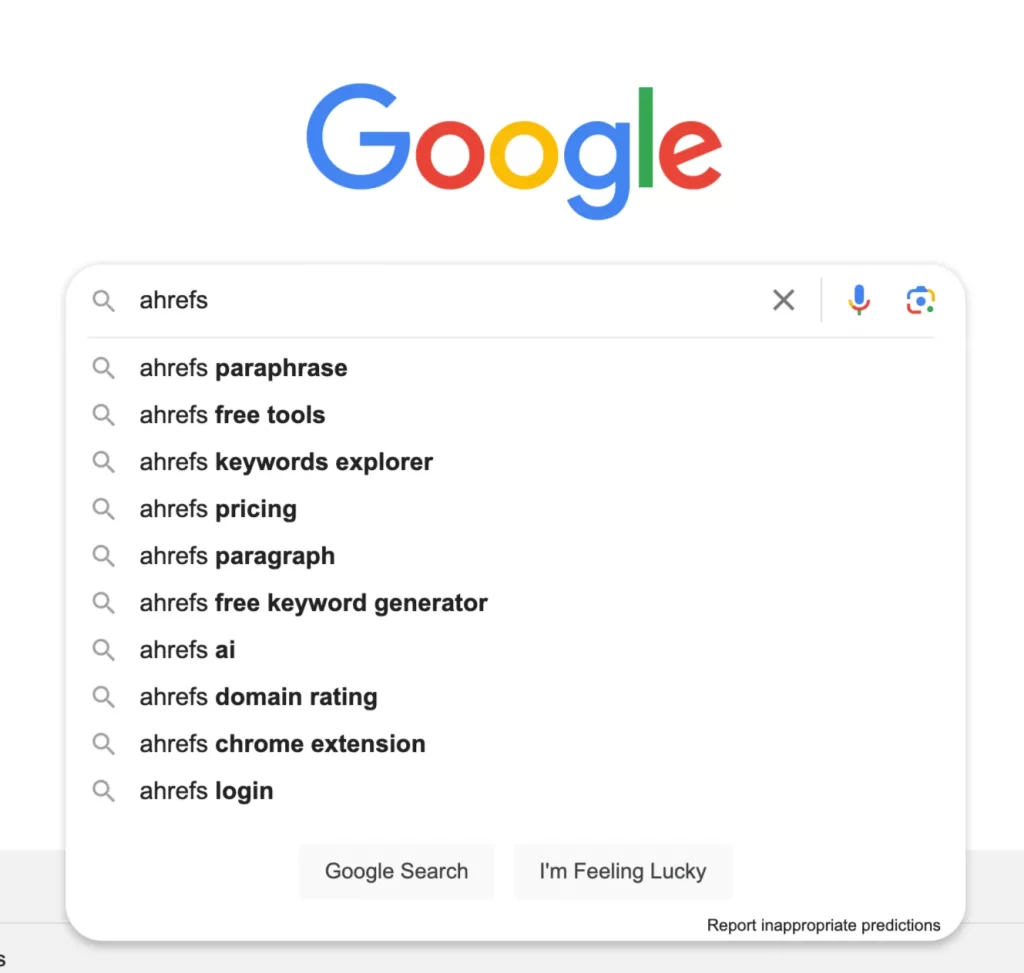
This is more useful for established sites in ensuring you’re building the right topical relevance of your brand (as to what topics and keywords you want your associate to be known for, at least on search).
Once you’ve identified semantically related keywords, you can use them as specific anchor texts for your links.
2. Learn How Real Publishers Reference Other People’s Works
Whether you’re creating new content on your site or external content on others’ blogs, make sure that you consider the natural approach of referencing the works of others.
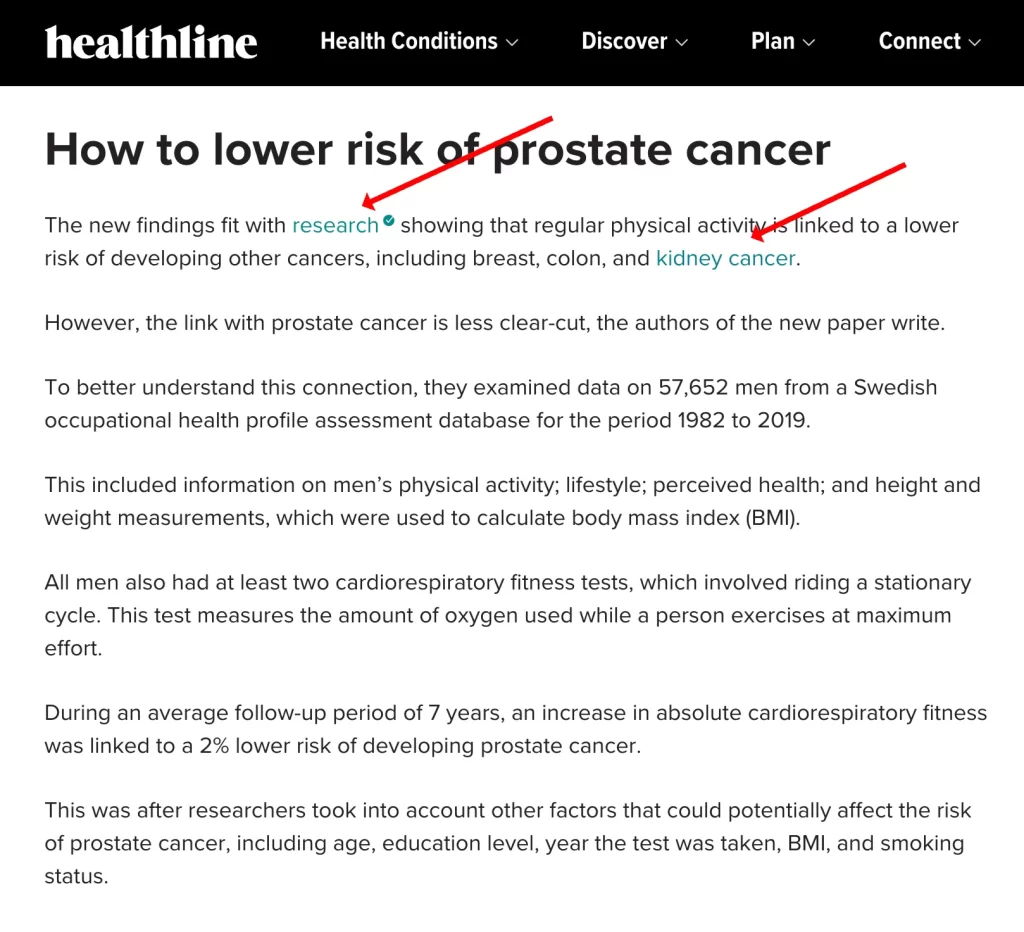
You can use highly descriptive anchor texts to provide more context to the linking page and help entice better user clicks from users (which also drives more referral traffic to your page).
Linking out to credible sources and properly citing others’ works helps increase trust (Google’s EEAT factor), depth of quality, and perceived value of your content.
This approach goes beyond the traditional approach of writing ‘guest posts’ to acquire inbound links. As we are all aware, the content from linking pages can assist in building your site’s topical authority (off-page).
3. Think Branding
Having worked with enterprise-level link acquisition campaigns for years, we’ve seen how top-level in-house SEOs value every face of link building, including how they choose the right anchor texts.
Obviously, they don’t want their sites to be affected by penalties and bad rankings (as it could result in millions of dollars lost for their business).
But more than that, they view link building as a branding tool. It affects how both search engines and users perceive their brand.
When building artificial links to your site, focus more on branded anchor texts (brand name, entity name, products, offerings, employees’ name, content assets, etc..).
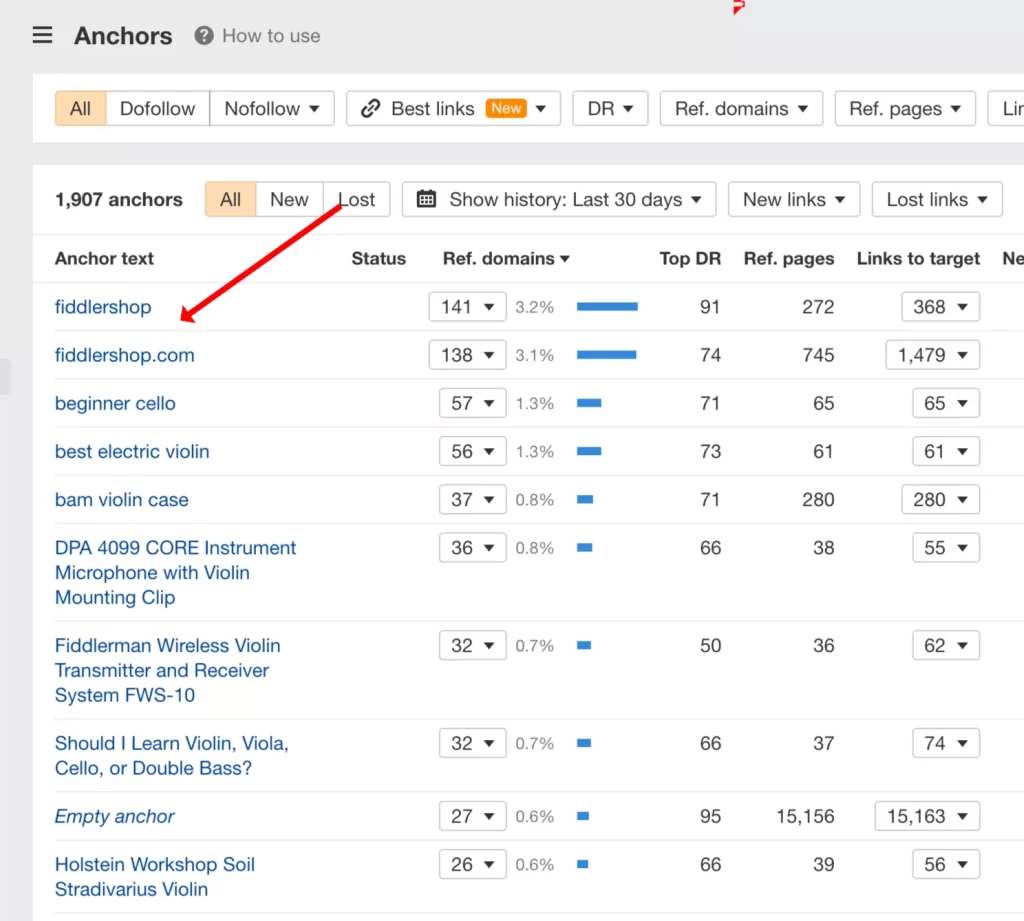
Utilizing branded anchor texts helps build awareness and curiosity about your brand from readers of other sites, who might eventually search for you on Google (increasing the volume of your site’s branded searches).
4. Explore Topics, Not Just Keywords
Research around topics to identify secondary keywords related to each industry.
If you’re doing an entirely new SEO campaign for a particular client, try to explore keyword themes using tools like Ahrefs or SEMRush.
Find interesting words your target audience uses to describe the topic. You can leverage these supporting keyword phrases to build external content around that central theme.
Note: Ahrefs has this feature (Clusters by Parent Topic).
5. Place LSI and Secondary Keywords On Linking Pages
Improve the quality of your external content assets (e.g., guest posts) by placing more LSI and secondary keywords within subheadings, images’ alt tags, and content body.
Invest time enhancing the reading experience and optimizing your external content to rank for multiple keyword variations on Google.
You can use more relevant Nouns and entities to enhance entity recognition (check out this Entity Optimization guide).
By referencing entities like direct or non-direct competitors, industry thought leaders, and personalities, you increase the topical relevance of your content, which brings more contextual understanding to your anchor texts.
Overall, it helps your site get the most value from every backlink produced.
6. Link to Rich and High-Value Content
Avoid misleading your readers by forcefully linking to sales pages to push rankings for target commercial keywords.
Implement a strict strategy with your team to link only to relevant informational pages.
Instead of pointing all links to landing pages, you can have a better holistic link building plan to create an internal linking system (linking your site’s informational pages to relevant landing pages.
This approach helps your site to pass link equity/power to other important pages without risking the current rankings of your commercial pages.
Keep users have a better reading experience throughout the content, as it affects both branding and user interaction signals.
Integrate Anchor Text Strategy To Overall Link Building Strategy
The key to optimizing anchor texts is understanding their role and impact on your entire link building strategy. It is a top-bottom approach to enhance every facet of the link building campaign.


